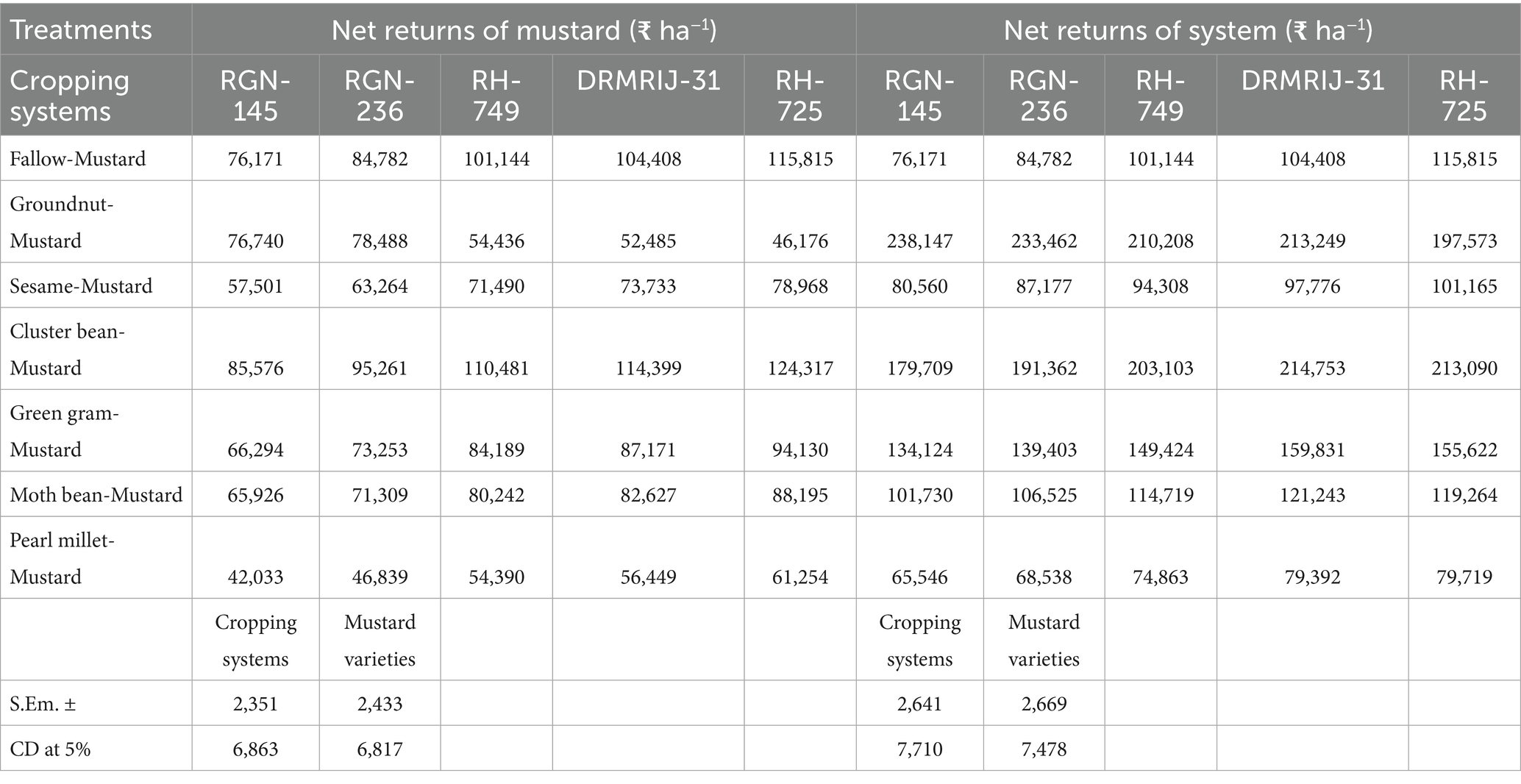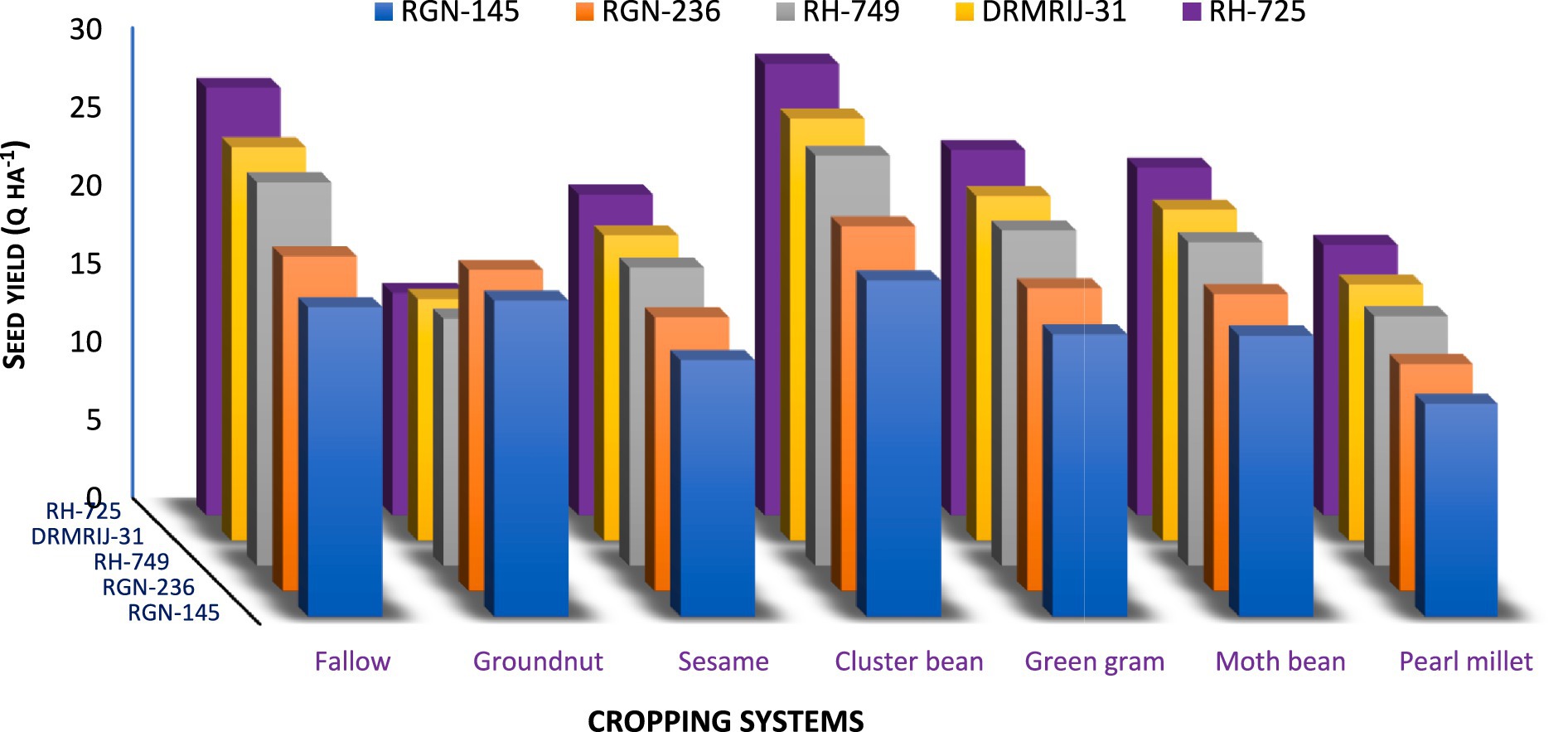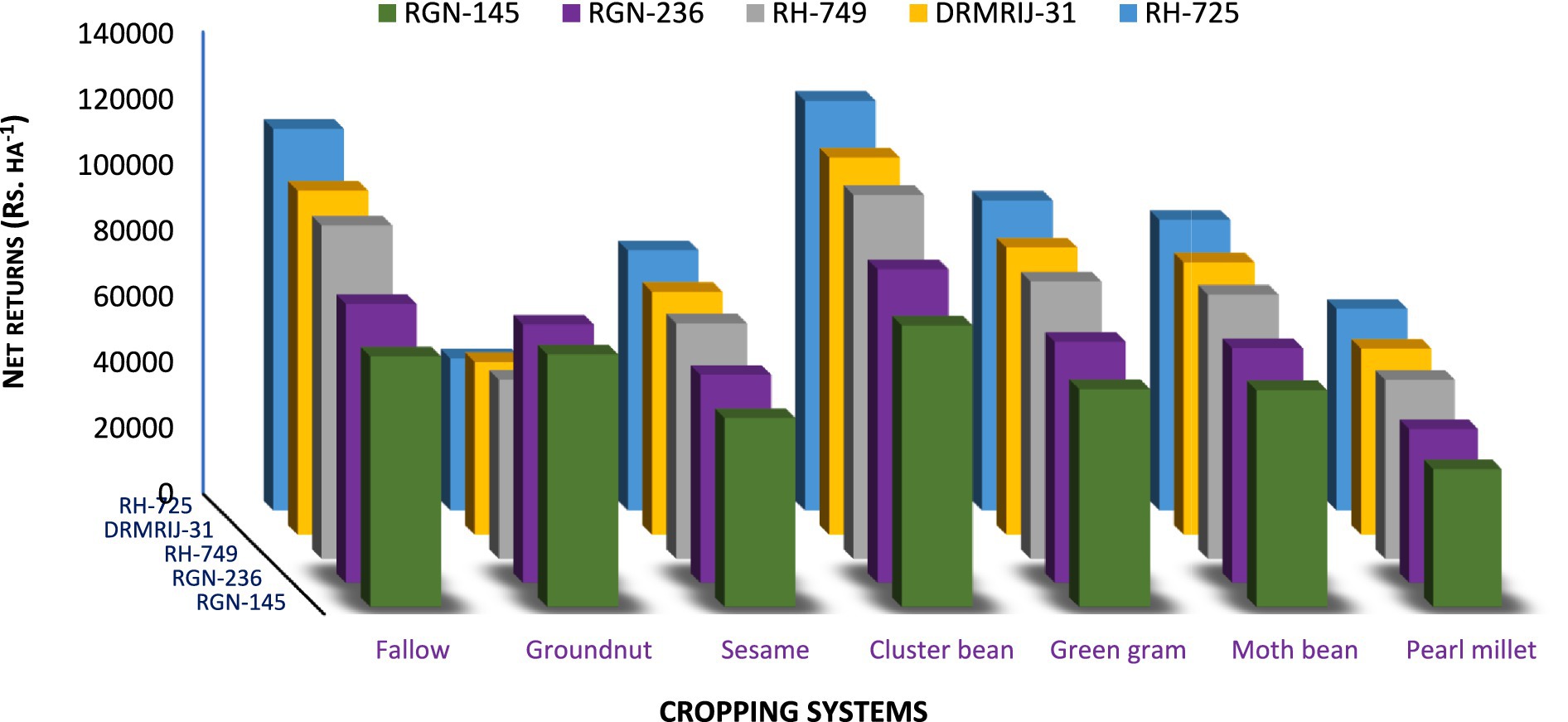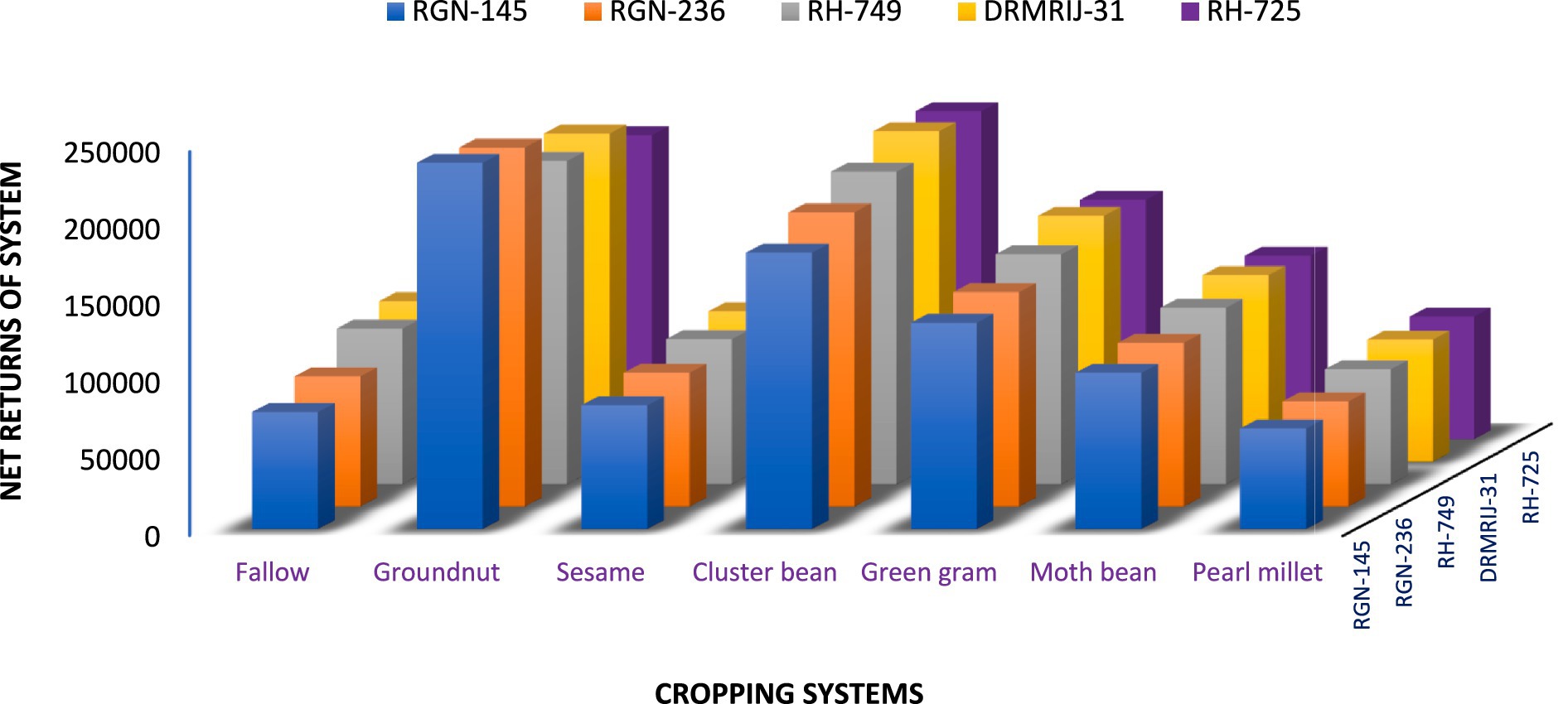- 1Swami Keshwanand Rajasthan Agricultural University, Bikaner, India
- 2School of Agriculture, Galgotias University, Greater Noida, Uttar Pradesh, India
- 3Department of Soil Science and Agricultural Chemistry, Sri Karan Narendra Agriculture University, Jaipur, Rajasthan, India
- 4Agricultural University, Jodhpur, India
- 5Department of Agricultural Engineering, College of Food and Agricultural Sciences, King Saud University, Riyadh, Saudi Arabia
- 6Structural Diagnostics and Analysis Research Group, Faculty of Engineering and Information Technology, University of Pécs, Pécs, Hungary
Context: Mustard (Brassica juncea L.) is a major oilseed crop in India, particularly suited to arid and semi-arid regions like Rajasthan, where low soil fertility, erratic rainfall, and limited irrigation resources constrain productivity. Diversifying cropping systems with legumes and selecting suitable mustard varieties are essential strategies for improving system productivity, enhancing resource use efficiency, and ensuring sustainable oilseed production in dryland agro-ecosystems.
Objective: This study aimed to evaluate the interactive effects of preceding crops and mustard varieties on system productivity, profitability, and land-use efficiency under arid conditions. The specific goals were to (i) assess the impact of kharif-season crops on mustard growth and yield, (ii) compare varietal performance across cropping systems, and (iii) identify optimal system–variety combinations for maximizing economic returns and resource-use efficiency.
Methods: A two-year field experiment (2021–22 and 2022–23) was conducted on loamy sand soils in Rajasthan using a split-plot design with three replications. The main plots included seven cropping systems: fallow-mustard, groundnut-mustard, sesame-mustard, cluster bean-mustard, green gram-mustard, moth bean-mustard, and pearl millet-mustard. Five mustard varieties (RGN-145, RGN-236, RH-749, DRMRIJ-31, and RH-725) were assigned to sub-plots. System productivity was evaluated using mustard equivalent yield (MEY and MESY), grain and straw yield, production efficiency, land resource use efficiency, net returns, and benefit–cost ratio (B:C). Significance was tested at p < 0.05.
Results: Significant differences were observed among cropping systems and mustard varieties for all measured indicators. The cluster bean-mustard system combined with RH-725 achieved the highest grain yield (1.95 t ha−1), straw yield (5.24 t ha−1), net returns (₹124,317 ha−1), and B: C ratio (4.55). In contrast, RGN-145 under the groundnut-mustard system produced the highest grain yield (2.21 t ha−1), net returns (₹238,147 ha−1), and B:C ratio (4.27) among all combinations. Additionally, RGN-145 and RGN-236 under the groundnut-mustard system recorded the highest mustard equivalent yield (MEGY), stover yield (MESY), and land-use efficiency, indicating their suitability for system intensification.
Conclusion: Legume-based cropping systems, particularly groundnut-mustard and cluster bean-mustard, significantly improved mustard productivity and profitability in arid environments. Their integration with high-performing varieties such as RGN-145 and RH-725 offers a viable pathway for sustainable intensification, improved soil health, and climate-resilient mustard production in dryland farming systems.
Introduction
Mustard (Brassica juncea [L.] Czernj. & Cosson), commonly referred to as Indian mustard or brown mustard, is a major oilseed crop cultivated globally, with its primary production concentrated in Asia and Africa (Sharma et al., 2022, 2024; Rai et al., 2022). In India, mustard holds a pivotal role in the agricultural economy, serving as a vital source of edible oil and contributing significantly to rural livelihoods (Sachan et al., 2024). The seeds are highly valued for their oil content, which typically ranges between 30 and 45%, and the oil is considered nutritionally superior due to its richness in unsaturated fatty acids, especially omega-3 and omega-6 fatty acids (Saini and Keum, 2018; Meyer et al., 2003). These fatty acids are known to support cardiovascular health, making mustard oil a preferred alternative to saturated fat-rich oils. In addition to oil, mustard seeds are a source of high-quality protein, dietary fiber, vitamins (such as vitamin E and B-complex), and essential minerals like calcium, magnesium, and phosphorus. This nutritional profile enhances the crop’s role in promoting food and nutritional security, especially in resource-constrained regions.
Agronomically, mustard is recognized for its relatively high tolerance to abiotic stresses such as drought and low temperatures. However, it is sensitive to waterlogging and excessive moisture, particularly during the flowering and pod-filling stages, which can negatively impact pollination, seed development, and final yield (Bodner et al., 2015). In the Indian state of Rajasthan—one of the leading mustard-producing regions—the crop is especially significant due to its adaptability to arid and semi-arid conditions. The state’s agricultural landscape is marked by erratic and scanty rainfall, high evapotranspiration, and nutrient-poor soils, all of which constrain agricultural productivity. In this context, Brassica juncea is particularly valued for its resilience and economic returns. Enhancing production in such challenging environments requires the implementation of climate-resilient agronomic practices, efficient nutrient and water management, and suitable varietal selection (Gawdiya et al., 2023a, b, c, 2024, 2025a; Gawdiya and Kumar, 2025). Such strategies are crucial not only for boosting yield and profitability but also for promoting sustainability in dryland farming systems (Sarkar et al., 2018; Gawdiya et al., 2025b).
The productivity of mustard (Brassica juncea) is strongly influenced by preceding crops and crop rotation strategies. Inclusion of diversified cropping systems not only optimizes land use but also improves soil fertility, nutrient cycling, and pest management, thus supporting sustainable agriculture (Gawdiya et al., 2025c). Studies highlight that intercropping or rotating mustard with legumes enhances yields due to complementary resource use and biological nitrogen fixation, which enriches soil nitrogen and reduces fertilizer dependency (Lietzow, 2021; Mirdoraghi et al., 2024).
Kumawat et al. (2022) reported that mustard-legume intercropping systems improve both yield and economic returns while reducing the risks of monoculture. This approach also enhances soil health and system resilience. The choice of preceding crops plays a critical role in mustard performance. Leguminous crops, in particular, increase soil fertility through nitrogen addition, while other crops can influence soil moisture, nutrient availability, and pest dynamics—factors essential for mustard establishment and productivity (Friedt et al., 2018; Liu et al., 2019; Wanic et al., 2019).
Furthermore, crop diversification, including mixed and rotational systems, has been shown to improve resource use efficiency and buffer crops against climate variability (Emran et al., 2022; Gawdiya et al., 2025b). In arid regions like Rajasthan, where mustard is a key oilseed, such practices are crucial for improving productivity, sustaining rural livelihoods, and ensuring food and nutritional security (Jain et al., 2024). Moreover, the selection of suitable mustard varieties plays a crucial role in optimizing productivity, particularly under region-specific agroecological conditions. Different varieties of Brassica juncea respond differently to environmental stresses, soil types, and cropping systems. Research has demonstrated that high-yielding and oil-rich cultivars can significantly enhance both seed output and oil recovery, addressing the rising demand for edible oils (Yadava et al., 2012). Varieties such as RH-749 and RH-725 have shown notable adaptability and performance in Rajasthan’s arid and semi-arid zones, where moisture scarcity and poor soil fertility prevail (Meena et al., 2018).
However, varietal profitability is not solely yield-dependent; it is also shaped by market access, input costs, and farmer adoption of improved agronomic practices. As Reddy et al. (2024) emphasize, economic feasibility—including cost–benefit ratios and price realization—is key to ensuring widespread adoption and long-term sustainability of mustard cultivation. This study aims to investigate the combined impact of preceding crops and mustard varieties on yield, growth, and profitability under the challenging agro-climatic conditions of Rajasthan. By analyzing the interaction between crop rotation choices and varietal responses, the research seeks to identify optimal combinations that maximize resource use efficiency, enhance soil health, and boost economic returns. Insights from this work will help inform location-specific, integrated management strategies for sustainable mustard production, benefiting both farmers and policymakers. The aim of this study is to assess the influence of preceding crops and mustard varieties on growth, yield, and profitability under arid conditions. The primary objectives are: (i) To evaluate the impact of preceding crops on growth, yield, and profitability of mustard under arid conditions; (ii) To assess the performance of different mustard varieties across diverse cropping systems. (iii) To analyze cropping system–variety interactions for optimizing system productivity, economic returns, and resource use efficiency.
Materials and methods
Site, soil, and climatic conditions
A two-year field experiment was conducted at the Krishi Vigyan Kendra, Lunkaransar, Swami Keshwanand Rajasthan Agricultural University, Bikaner, India, located at a longitude of 73°–76° E, latitude of 31°–26° Nand an elevation of 135 m. The study spanned the cropping seasons of 2021–22 and 2022–23. The region’s soil is classified as loamy sand, with a chemical analysis indicating a pH of 7.6, 0.38% soil organic matter, an electrical conductivity of 0.35 dSm−1, total nitrogen content of 0.05%, extractable phosphorus at 6.88 mg kg−1and extractable potassium at 163 mg kg−1. The climatic conditions are characterized by hot summers and cool winters typical of the arid regions of Rajasthan. Average rainfall during the cropping seasons is variable, necessitating irrigation for optimal crop establishment and growth due to erratic rainfall patterns. Temperature ranges significantly, with summer temperatures exceeding 40°C and winter temperatures dropping to around 5°C.
Experimental details
The experiment aimed to assess the economics and profitability of five mustard varieties: RGN-145, RGN-236, RH-749, DRMRIJ-31and RH-725, sown under seven different mustard-based cropping systems. The cropping systems included fallow-mustard, groundnut-mustard, sesamum-mustard, cluster bean-mustard, green gram-mustard, moth bean-mustard and pearl millet-mustard. A split-plot design was employed, where the cropping systems were assigned to the main plots and the mustard varieties were arranged in sub-plots, with three replications for statistical validity. This design facilitated a comprehensive analysis of the interactions between cropping systems and mustard varieties.
Date of sowing
In the kharif season, groundnut was sown on June 15 in both years, while other kharif crops were sown on July 15. The mustard varieties were sown on November 15 during the rabi seasons. In the Groundnut-Mustard system, all mustard varieties were sown on December 01 due to the delayed harvesting of groundnut.
Crop husbandry
Prior to seedbed preparation, a pre-sowing irrigation of 10 cm (approximately 4 inches) was applied to ensure adequate soil moisture. Subsequently, light irrigations of 5 cm were provided at regular intervals throughout the crop growth period to maintain optimal soil moisture conditions. Seedbeds were prepared when the soil reached field capacity according to the assigned treatments. Throughout the growing season, a total of six irrigations were provided to the mustard crop to mitigate moisture stress. All crops were manually harvested upon reaching maturity. At harvest, 11 central rows from each plot were collected, sun-dried for 1 week, manually threshed and the grains were separated and weighed to calculate seed yield, reported in quintals per hectare. All seed yields were adjusted to 10% moisture content for consistency.
Data collection
Seed yield data from the mustard crop were compiled to compute the economics and profitability of each cropping system. Yield data from all crops were recorded to facilitate comprehensive economic analysis. The Benefit–Cost Ratio was calculated using the formula: BCR = Total income/Total expenditures.
Yield and Efficiency Indicators for System Performance Evaluation: To assess system performance across cropping systems and mustard varieties, the following indicators were calculated (Kundu and Mahapatra (2014):
1. Mustard Equivalent Yield during Kharif (MEGY)
The yield of preceding (kharif) crops was converted into mustard equivalent yield using the formula:
where:
Yk = yield of kharif crop (q ha−1)
Pk = market price of kharif crop (₹ q−1)
Pm = market price of mustard (₹ q−1)
2. Mustard Equivalent Yield of the System (MESY)
To compare overall productivity, the total yield of the system (including kharif and mustard crops) was expressed in mustard equivalent terms:
3. Economic Performance
Economic performance was evaluated based on net returns and the benefit–cost ratio (B:C):
a. Net Returns (₹ ha−1):
Net Return = Gross Return − Cost of Cultivation
Benefit–Cost Ratio (B:C):
b. B:C Ratio = Gross Return − Cost of Cultivation.
4. Production Efficiency (PE)
Production efficiency quantifies system productivity over time and was calculated using:
5. Land Resource Use Efficiency (LRUE)
LRUE represents the proportion of the year during which land is under productive use:
Statistical analysis
Statistical analysis was performed using the latest version of open-access RStudio software (version 2023.03.1–446) (Mendiburu and Yaseen, 2023). Before pooling, year-wise data were tested for homogeneity of variances using Bartlett’s test. Since no significant heterogeneity was observed, data from both years were pooled for combined analysis. Appropriate error terms were applied to evaluate treatment effects and their interactions (e.g., Cropping System × Variety, Year × Treatment) using a linear model framework in R. Where interaction effects were significant, results were interpreted accordingly. Treatment mean comparisons were made using the Least Significant Difference (LSD) test at the 5% significance level (p ≤ 0.05). Additionally, Standard Error of Means (SEm) and Critical Difference (CD) values were computed to support comparisons.
Results and discussions
Phenological performance
The phenological performance of mustard varieties under different cropping systems, as presented in Table 1, reveals significant variations in growth parameters, including days to emergence, branching, flowering, siliqua formation and maturity. Understanding these parameters is crucial for optimizing mustard cultivation practices. The fallow-mustard system demonstrated the shortest days to emergence (4.6 days), indicating that optimal soil moisture and nutrient availability facilitated quicker germination. In contrast, both groundnut-mustard and sesame-mustard systems showed slightly longer emergence times (5.2 and 5.1 days, respectively). This may suggest that the presence of preceding crops could impact soil conditions negatively (Krupinsky et al., 2006). The pearl millet-mustard system also recorded a similar emergence time (4.6 days), implying that certain fast-growing crops do not adversely affect mustard germination. The number of days to branching varied significantly among treatments. The cluster bean-mustard system required the longest time (39.8 days) for branching to occur, which could be attributed to the interactions between the two species that may prolong vegetative growth to enhance resource acquisition (Nord and Lynch, 2009). Conversely, the pearl millet-mustard system exhibited the shortest branching period (36.6 days), suggesting that this system might promote quicker transitions from germination to branching due to lesser competition. The days to 50% flowering and siliqua formation are critical milestones in the reproductive phase of mustard. The fallow-mustard and cluster bean-mustard systems led to the longest flowering and siliqua formation times (61.3 and 80.2 days, 62.7 and 81.9 days, respectively). These extended periods might be beneficial, allowing plants to allocate resources for reproductive success (Jain et al., 2023). The groundnut-mustard and sesame-mustard systems showed earlier flowering (59.3 and 59.0 days, respectively), potentially indicating faster transition rates under lower competition conditions. Maturity is a crucial factor affecting the total crop cycle and yield potential. The cluster bean-mustard system required the longest duration to reach maturity (141.4 days), which may enhance seed development and overall yield. In contrast, the groundnut-mustard system matured significantly earlier (123.6 days), which can be advantageous for early harvesting but may limit potential yield (Verma et al., 2020). The differences in maturity times indicate that selection of cropping systems can be tailored based on desired harvest timings and overall management strategies.
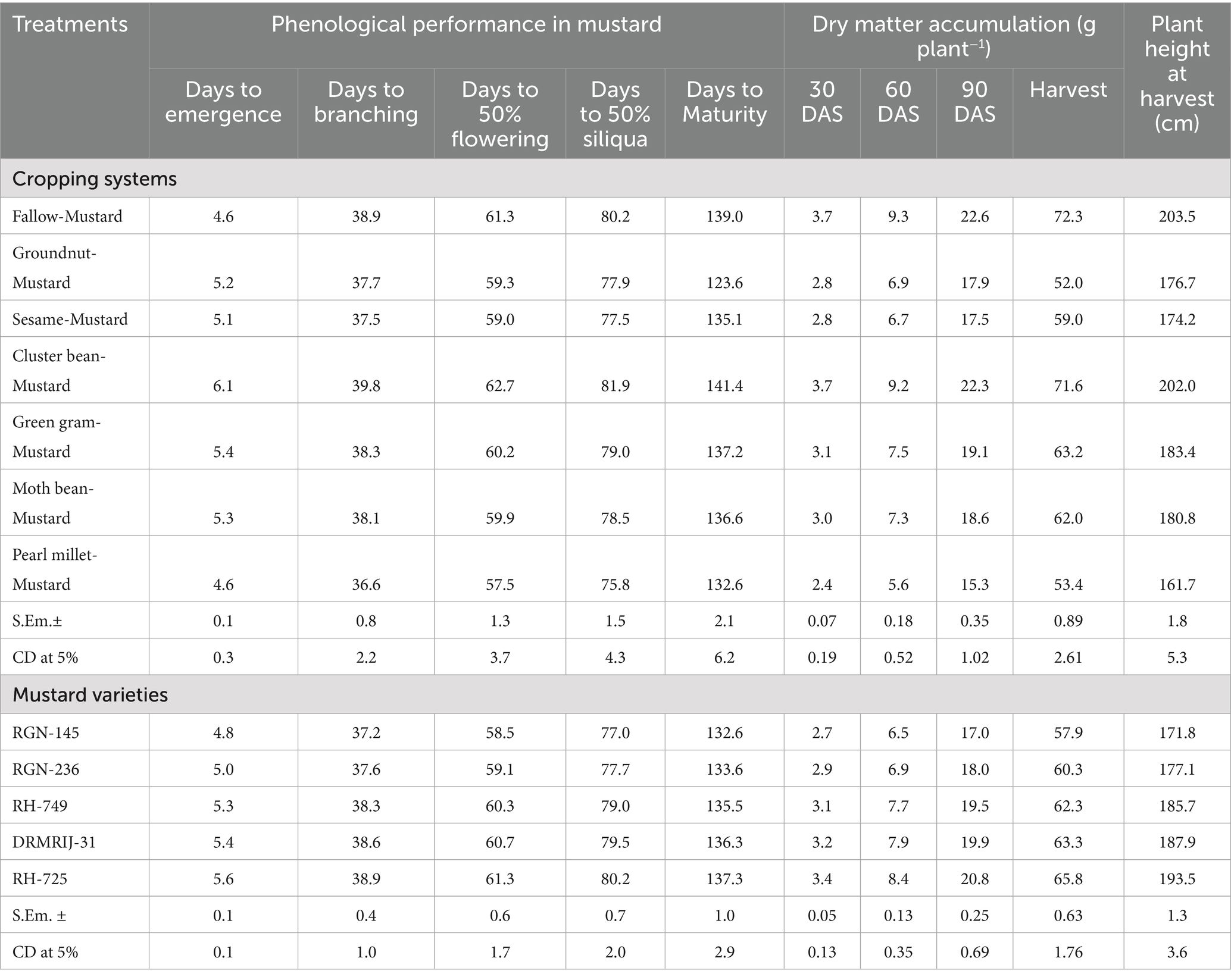
Table 1. Phenological performance and growth parameters of mustard varieties under different cropping systems (pooled of 2 years).
Effect of mustard varieties on phenological performance of mustard varieties
The phenological performance of five mustard varieties was assessed over a two-year period, with results summarized in Table 1. Key metrics evaluated include days to emergence, branching, flowering, siliqua formation and maturity. These factors are critical for understanding the growth dynamics and potential yield of mustard crops. Among the varieties, RGN-145 exhibited the shortest days to emergence (4.8 days), followed closely by RGN-236 (5.0 days). These results suggest that these varieties may have superior germination characteristics under the studied conditions, which is essential for achieving optimal plant establishment (Kumar et al., 2022). Conversely, RH-725 took the longest to emerge (5.6 days), which may reflect its specific seed characteristics or response to environmental conditions (Patel et al., 2021). The branching phase is crucial for determining the potential for flower and pod development. The shortest time to branching was noted in RGN-145 (37.2 days), indicating its rapid vegetative growth, while RH-725 required the most time (38.9 days). The differences in branching times can be attributed to genetic variations among the varieties, with faster branching likely translating to better resource utilization during the vegetative stage (Singh et al., 2019). RH-725 recorded the longest duration to reach 50% flowering (61.3 days), while RGN-145 was the earliest (58.5 days). Earlier flowering in RGN-145 may lead to a longer seed filling period, potentially enhancing yield (Jain et al., 2023). This observation supports the idea that phenological traits, such as flowering time, are critical for optimizing harvests in mustard cultivation (Kaur et al., 2020). Siliqua formation is vital for mustard yield and here again, RH-725 exhibited the longest period (80.2 days) for this metric, while RGN-145 had the shortest (77.0 days). The longer duration for siliqua formation in RH-725 may suggest a delayed reproductive phase, which could affect overall yield if not balanced with environmental conditions (Rani et al., 2021). Maturity is a key determinant of yield potential, with RH-725 maturing last (137.3 days) and RGN-145 maturing the earliest (132.6 days). The extended maturity of RH-725 may enhance its seed development, yet it also increases the risk of environmental stress if the growing season is prolonged (Singh et al., 2022). Thus, variety selection should consider both maturity time and the local climate to optimize yield.
Growth parameters
The growth parameters of mustard varieties, assessed across different cropping systems over a two-year period, are summarized in Table 1. Key metrics include dry matter accumulation at various growth stages and plant height at harvest. These parameters are essential for understanding the growth dynamics and potential yield of mustard crops. Dry matter accumulation is a vital indicator of plant growth and health. At 30 days after sowing (DAS), the fallow-mustard and cluster bean-mustard systems exhibited the highest dry matter accumulation (3.7 g plant−1). This indicates that these systems provide better conditions for early vegetative growth, likely due to reduced competition and enhanced nutrient availability (Jain et al., 2023). In contrast, the pearl millet-mustard system resulted in the lowest dry matter accumulation at 30 DAS (2.4 g plant−1). This reduced growth may be attributed to competition for resources, as pearl millet is a vigorous crop that may deplete soil nutrients (Kumar et al., 2022). At 60 DAS, similar trends were observed, with fallow-mustard (9.3 g plant−1) and cluster bean-mustard (9.2 g plant−1) continuing to outperform the other systems. The groundnut-mustard and sesame-mustard systems recorded lower dry matter accumulations (6.9 and 6.7 g plant−1, respectively), suggesting that the preceding crops might inhibit the growth of mustard through resource competition (Rani et al., 2021; Huhta et al., 2000). Plant height at harvest is another critical parameter for evaluating crop performance. The fallow-mustard system achieved the tallest plants (203.5 cm), followed closely by cluster bean-mustard (202.0 cm). This may indicate that these cropping systems provide optimal conditions for mustard growth, promoting taller plant stature and, potentially, higher yields (Singh et al., 2019). Conversely, the pearl millet-mustard system resulted in the shortest plants at harvest (161.7 cm). This could be a reflection of the competitive dynamics between the crops, where the vigorous growth of pearl millet adversely affects mustard height (Palaniappan, 2006; Thakur et al., 2022). The plant heights recorded in other systems, such as green gram-mustard (183.4 cm) and moth bean-mustard (180.8 cm), suggest that these crops may offer moderate conditions for mustard growth, though not as favourable as the fallow and cluster bean systems.
Effect of mustard varieties on growth components
The growth parameters of mustard varieties were analysed across a two-year period, focusing on dry matter accumulation at various growth stages and plant height at harvest. The findings are summarized in Table 1, which outlines the performance of five mustard varieties. Dry matter accumulation is a critical indicator of plant growth and health. At 30 days after sowing (DAS), RH-725 demonstrated the highest dry matter accumulation (3.4 g plant−1), followed by DRMRIJ-31 (3.2 g plant−1). This suggests that these varieties may have superior early vigour, enabling them to capitalize on available resources during the initial growth phase (Kumar et al., 2022). By 60 DAS, RH-725 continued to lead in dry matter accumulation (8.4 g plant−1), which is consistent with its overall trend of vigorous growth. This high accumulation can enhance subsequent growth stages and is often correlated with improved yield potential (Singh et al., 2019). In contrast, RGN-145 recorded the lowest dry matter at this stage (6.5 g plant−1), indicating that it may be less competitive in early growth compared to the other varieties. At 90 DAS, RH-725 again maintained its lead with 20.8 g plant−1, while RGN-145 had the lowest accumulation (17.0 g plant−1). The differences observed suggest genetic variability in growth rates among the varieties, with certain genotypes being more adept at resource utilization during critical growth phases (Jain et al., 2023). Plant height at harvest is a key determinant of overall yield potential. At harvest, RH-725 achieved the greatest height (193.5 cm), followed closely by DRMRIJ-31 (187.9 cm) and RH-749 (185.7 cm). These results indicate that these varieties may possess desirable traits for vertical growth, which is crucial for maximizing light interception and photosynthetic efficiency (Thakur et al., 2022). In contrast, RGN-145 had the shortest height at harvest (171.8 cm). The reduced height may limit its competitive ability in the field and could result in lower yield potential if not adequately compensated by other growth traits (Kaur et al., 2020). The statistical analysis confirms significant differences in plant height among the varieties, with a critical difference (CD) of 3.6 cm at a 5% significance level, highlighting the importance of selecting taller varieties for higher yield.
Physiological components
The physiological performance of mustard varieties under different cropping systems was assessed through crop growth rate (CGR) and relative growth rate (RGR) over various growth intervals. The results, summarized in Table 2, reveal significant variations in both CGR and RGR across different cropping systems. Across the cropping systems, the fallow-mustard system exhibited the highest CGR during the critical growth phase from 90 DAS to harvest (54.68 g m−2 day−1), indicating optimal growth conditions. This is consistent with findings that fallow systems often provide enhanced nutrient availability and reduced competition (Liebman, 2000; Gupta et al., 2022). The cluster bean-mustard system also demonstrated strong performance with a CGR of 54.18 g m−2 day−1 during the same period, suggesting that the inclusion of cluster beans may contribute positively to mustard growth dynamics through improved soil health and nutrient cycling (Kumar et al., 2021a). Conversely, the pearl millet-mustard system recorded the lowest CGR at 41.91 g m−2 day−1 during the final growth phase. This reduced growth rate may be attributed to competition for resources, as pearl millet is known for its aggressive growth habits, which could hinder mustard performance (Sudhalakshmi et al., 2022). RGR, expressed in mg g−1 day−1, provides insights into the efficiency of biomass accumulation relative to the existing biomass. The fallow-mustard system also led in RGR across most intervals, with an RGR of 141.02 mg g−1 day−1 from 90 DAS to harvest. This high value reflects not only vigorous growth but also effective resource utilization (Verma et al., 2023). The groundnut-mustard and sesame-mustard systems exhibited moderate RGR values (155.56 mg g−1 day−1 and 134.18 mg g−1 day−1, respectively) at the end of the growth period, indicating that while they may support mustard growth, they do not match the efficiency of the fallow system (Kaur et al., 2020).
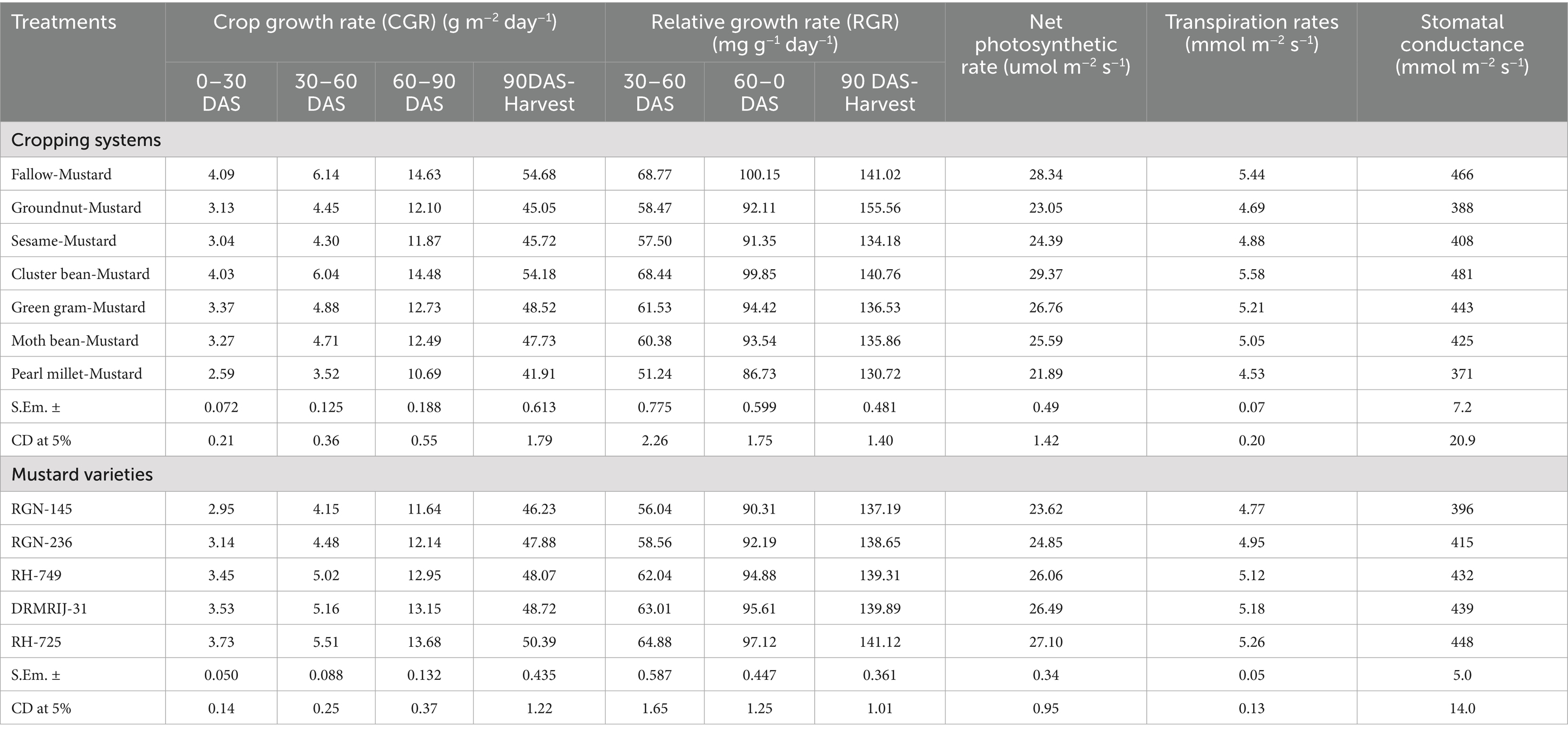
Table 2. Performance of physiological preformation of mustard varieties under different cropping systems (pooled of 2 years).
Effect of mustard varieties on physiological components
The physiological performance of mustard varieties, characterized by crop growth rate (CGR) and relative growth rate (RGR), was evaluated over a two-year period. The results are summarized in Table 2, highlighting the performance of five mustard varieties across different growth intervals. Among the varieties, RH-725 exhibited the highest CGR during the 90 DAS to harvest phase, with a value of 50.39 g m−2 day−1. This suggests that RH-725 has a superior ability to accumulate biomass during the critical final growth stage, which is essential for maximizing yield (Gupta et al., 2022). Conversely, the lowest CGR was observed in RGN-145 (46.23 g m−2 day−1) during the same period. This reduced growth rate may indicate lower efficiency in utilizing available resources, impacting its overall yield potential (Gill et al., 2021). The statistical analysis reveals significant differences among varieties, with a critical difference (CD) of 1.22 g m−2 day−1 at a 5% significance level, highlighting the relevance of selecting high-CGR varieties for improved productivity. In the earlier growth stages, RH-725 also showed consistent performance with CGR values increasing from 3.73 g m−2 day−1 at 0–30 DAS to 5.51 g m−2 day−1 at 30–60 DAS. This upward trend suggests strong early vigour, which is critical for establishing a robust canopy and effective light interception (Jain et al., 2023).
The highest RGR was noted in RH-725 across most intervals, reaching 141.12 mg g−1 day−1 from 90 DAS to harvest. This indicates effective resource utilization and highlights the genotype’s ability to convert biomass into yield (Verma et al., 2023). DRMRIJ-31 also performed well with an RGR of 139.89 mg g−1 day−1 during the final growth stage. These findings support the notion that these varieties possess genetic traits favourable for rapid biomass accumulation, crucial for achieving high yields (Kumar et al., 2022). The lower RGR values observed in RGN-145 (137.19 mg g−1 day−1) suggest that while it accumulates biomass, it may not be as efficient as the higher-performing varieties. The differences in RGR among the varieties were statistically significant, as indicated by the CD value of 1.01 at the 5% level, affirming the need for careful variety selection based on growth efficiency.
Yield and yield attributes
The performance of yield attributing parameters, yield and harvest index for mustard varieties under various cropping systems was assessed over a two-year period, with results summarized in Table 3. This study focused on key parameters including branches per plant, siliquae per plant, siliqua length, seeds per siliqua, test weight, seed yield, stover yield, biological yield and harvest index. The data indicates that the green gram-mustard system yielded the highest branches per plant (8.7), followed closely by the cluster bean-mustard system (8.6). Higher branching contributes to increased yield potential by allowing more flower and seed formation (Kumar et al., 2021). Conversely, the sesame-mustard system produced the lowest branching (8.2). The cluster bean-mustard cropping system exhibited the highest number of siliquae per plant (183.6), while the groundnut-mustard system had the lowest (155.7). The number of siliquae is a crucial yield component, as it directly influences seed yield (Hasanuzzaman, 2008; Gupta et al., 2020). The longest siliquae were found in the cluster bean-mustard system (4.6 cm), indicating favourable conditions for seed development. This is in line with research that suggests longer siliquae can accommodate more seeds, thus enhancing yield (Verma et al., 2023). In contrast, the pearl millet-mustard system recorded the shortest siliquae (3.5 cm). The fallow-mustard system produced the highest average seeds per siliqua (13.3), while the groundnut-mustard system had the lowest (9.3). A higher number of seeds per siliqua is beneficial for overall yield and indicates optimal growing conditions (Jain et al., 2023). The test weight was highest in the cluster bean-mustard system (4.76 g), which is significant for seed quality and overall yield potential. The lowest test weight was observed in the pearl millet-mustard system (4.38 g). Higher test weights generally correlate with better seed viability and yield (Gill et al., 2021). The cluster bean-mustard system achieved the highest seed yield (25.36 q ha−1), which aligns with the higher values of yield attributing parameters in this treatment. In contrast, the pearl millet-mustard system produced the lowest seed yield (15.56 q ha−1). The positive correlation between yield attributes and seed yield suggests that optimizing preceding crops can enhance mustard productivity (Kumar et al., 2022). Stover yield was also highest in the cluster bean-mustard system (38.66 q ha−1), indicating a robust growth pattern that supports both seed and biomass production. The lowest stover yield was recorded in the groundnut-mustard system (29.96 q ha−1). The cluster bean-mustard system had the highest biological yield (64.03 q ha−1), which encompasses both seed and stover yields, showcasing the system’s overall productivity. Conversely, the pearl millet-mustard system had the lowest biological yield (43.53 q ha−1). The harvest index, which indicates the efficiency of converting biomass into yield, was highest in the fallow-mustard system (38.32%), suggesting favourable conditions for yield accumulation. The pearl millet-mustard system exhibited the lowest harvest index (35.55%).
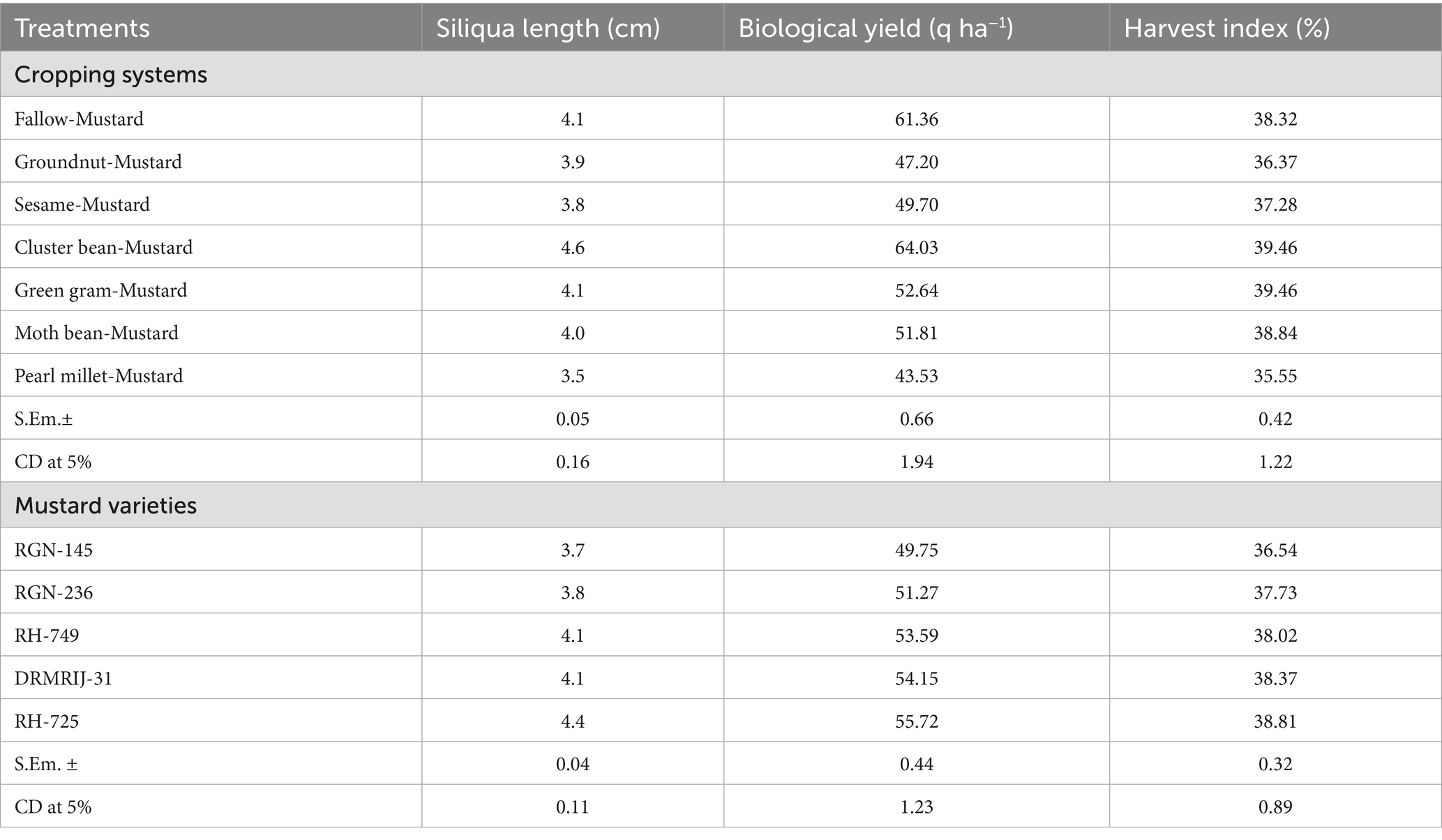
Table 3. Performance of yield attributing parameters, yield and harvest index of mustard varieties under different cropping systems (pooled of 2 years).
Effect of mustard varieties on yield attributing parameters and yield
This section discusses the findings from Table 3, which presents the yield attributing parameters, yield and harvest index of various mustard varieties over a pooled two-year period. The analysis provides insights into how different parameters contribute to the overall performance of mustard cultivation. The varieties RH-749 and RH-725 exhibited the highest average branches per plant (8.6 and 8.8, respectively), indicating robust vegetative growth. Increased branching is often associated with higher yield potential, as it allows for more flowering sites (Kumar, 2021). Conversely, RGN-145 showed the lowest number of branches (7.8). The DRMRIJ-31 variety had the highest siliquae per plant (176.8), suggesting a favourable environment for seed setting and development. A greater number of siliquae directly correlates with increased seed yield, confirming findings by Gupta et al. (2022). The lowest count was seen in RGN-145 (152.6). The RH-725 variety recorded the longest siliquae (4.4 cm), which is advantageous for accommodating more seeds, thus enhancing yield potential (Bansal and Kumar, 2022). In contrast, RGN-145 had the shortest siliqua length (3.7 cm). The highest average seeds per siliqua were recorded for RH-725 (12.5), showcasing its efficiency in seed development. A higher seed count per siliqua is crucial for maximizing overall yield, as supported by research conducted by Thakur et al. (2023). Notably, DRMRIJ-31 and RH-725 had the highest test weights (5.04 g and 5.09 g, respectively). Higher test weights are indicative of seed quality and can influence market value (Gill et al., 2021).
The RH-725 variety achieved the highest seed yield (21.95 q ha−1), closely followed by DRMRIJ-31 (20.93 q ha−1). This trend correlates with their superior performance in yield attributing parameters. RGN-145 recorded the lowest seed yield (18.23 q ha−1), indicating the impact of lower branching and siliquae counts on overall productivity (Jain et al., 2023). Similar to seed yield, the RH-725 variety also exhibited the highest stover yield (33.77 q ha−1), suggesting a well-balanced growth that contributes to both seed and biomass production. In contrast, RGN-145 had the lowest stover yield (31.52 q ha−1). The RH-725 variety again led in biological yield (55.72 q ha−1), demonstrating its overall productivity. The biological yield encompasses both seed and stover yields, highlighting the variety’s efficiency in resource utilization. The lowest biological yield was observed in RGN-145 (49.75 q ha−1). The harvest index, a measure of the efficiency of biomass conversion into economic yield, was highest in RH-725 (38.81%). A high harvest index indicates effective utilization of resources for seed production, a critical factor in sustainable agriculture (Kumar et al., 2021). RGN-145 had the lowest harvest index at 36.54% (Tables 4, 5).

Table 4. Interaction effect of different cropping systems on branches and siliquae per plant of mustard varieties (pooled).

Table 5. Interaction effect of different cropping systems on number of seeds per siliqua and test weight of mustard varieties (pooled).
Interaction effects of different cropping systems on yield of mustard varieties
The pooled data (Tables 6–8; Figures 1, 2) on the seed, stover yield and mustard equivalent yield of systems (MEYS) of mustard varieties under different cropping systems reveal significant interactions that impact agricultural productivity. The findings from this study highlight the variations in yield performance, which can be critical for optimizing mustard cultivation. The seed yield analysis shows that the Cluster bean-Mustard cropping system consistently produced the highest seed yields across all mustard varieties. Specifically, RH-725 achieved the maximum seed yield of 28.83 q ha−1, followed closely by DRMRIJ-31 with 26.95 q ha−1. This performance can be attributed to the synergistic effects of intercropping, where the legumes likely enhance nutrient availability and reduce competition stress, leading to improved seed set (Kumar, 2021). In contrast, the Pearl millet-Mustard system exhibited the lowest seed yields, with RGN-145 producing just 13.63 q ha−1. This lower yield may be due to the competitive nature of pearl millet for resources, adversely affecting the growth of mustard (Gupta et al., 2022). When assessing stover yield, the Fallow-Mustard system yielded the highest overall stover quantities, particularly in the variety RH-725, which recorded a stover yield of 38.84 q ha−1. This suggests that the absence of competition from other crops allows for optimal growth and biomass accumulation in mustard (Rani et al., 2023). In comparison, the Groundnut-Mustard system resulted in the lowest stover yields, especially in the variety RH-749 at 31.40 q ha−1. This decline in stover yield may reflect the lower biomass accumulation capacity due to resource competition from groundnuts (Jain et al., 2021).
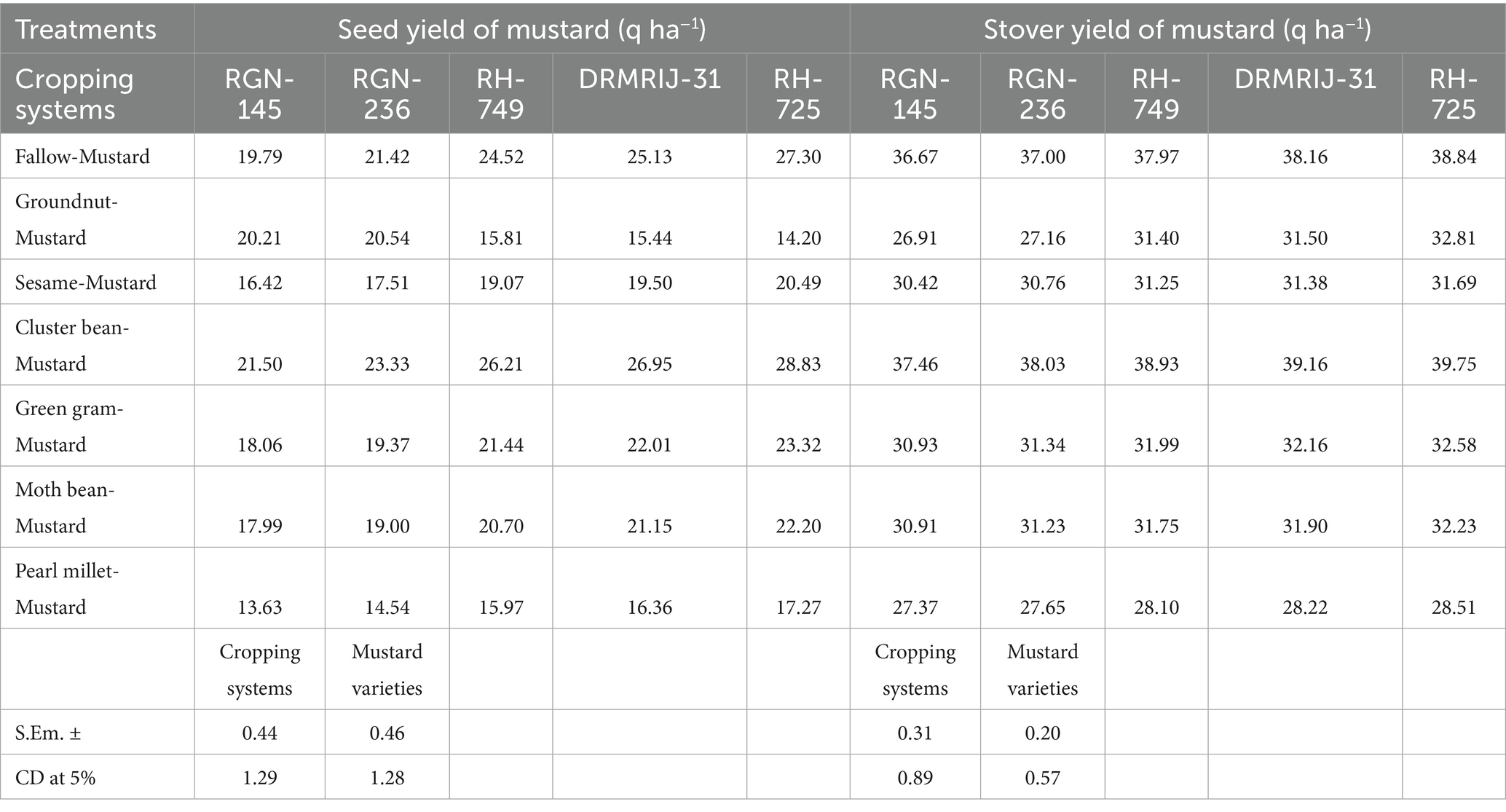
Table 6. Performance of seed and stover yield of mustard varieties under different cropping systems (pooled).
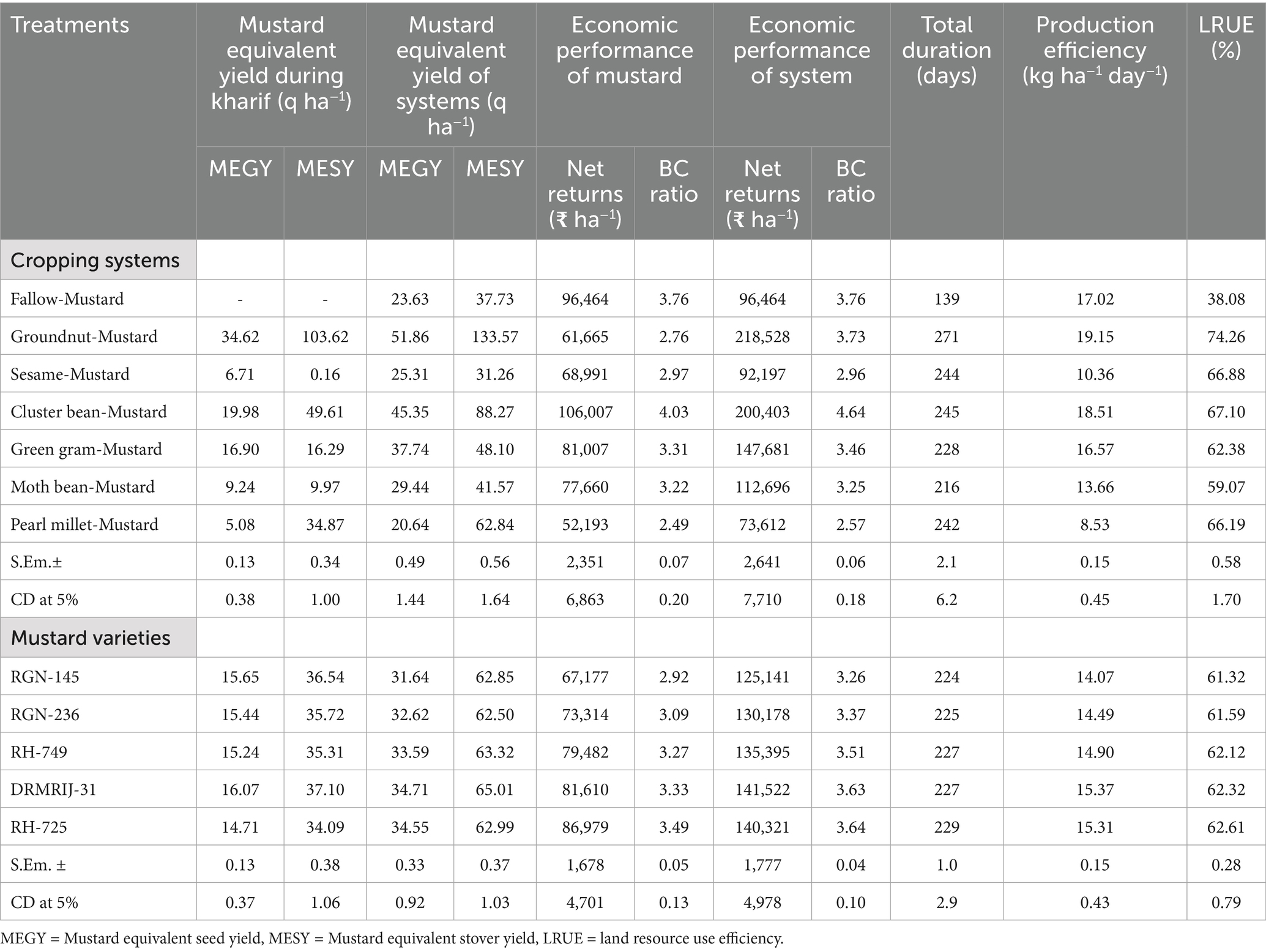
Table 7. Mustard equivalent yield, economic performance, production efficiency and land resource use efficiency of mustard varieties under different cropping systems (pooled of 2 years).
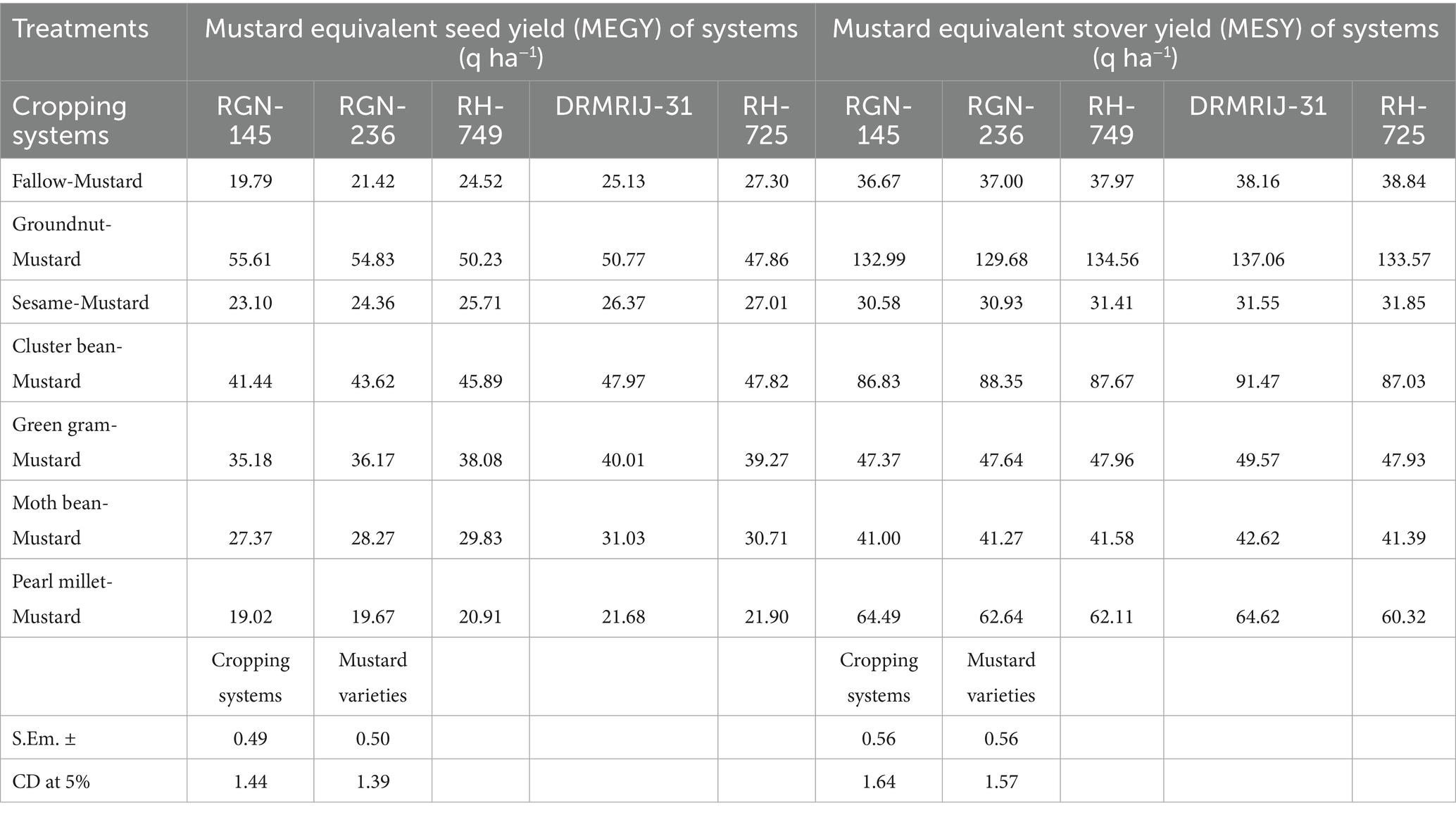
Table 8. Mustard equivalent yield of system (MEYS) of mustard varieties under different cropping systems (pooled).
The Groundnut-Mustard cropping system yielded the highest mustard equivalent seed yields across all varieties, with RGN-145 achieving 55.61 q ha−1 and RGN-236 close behind at 54.83 q ha−1. This significant yield advantage can be attributed to the favourable nutrient cycling and enhanced soil fertility provided by groundnuts, which are known to fix atmospheric nitrogen, thus benefiting the subsequent mustard crop (Singh et al., 2021). In contrast, the Pearl millet-Mustard system produced the lowest MEGY, with RGN-145 at 19.02 q ha−1. This lower yield likely results from competitive resource utilization, where pearl millet may overshadow mustard during the growth phase (Kumar et al., 2022). Regarding stover yield, the Groundnut-Mustard system again led, with RGN-145 yielding 132.99 q ha−1. This highlights the dual benefits of intercropping, where both cash and fodder crops are optimized, aligning with sustainable agricultural practices (Rani et al., 2023). The stover yields in this system demonstrate the importance of legume intercrops in enhancing biomass production. The Pearl millet-Mustard combination yielded the lowest MESY, with RGN-145 at 64.49 q ha−1. The results suggest that intercropping with pearl millet may not effectively support stover production, likely due to competition for light and nutrients, which can adversely affect both crops (Jain et al., 2021).
Economic and efficiency indices
The evaluation of mustard equivalent yield (MEY) under different cropping systems provides critical insights into the productivity of mustard varieties over 2 years (Table 7). The results indicate that among the various cropping systems, groundnut-mustard significantly outperformed others, yielding a mustard equivalent yield during kharif (MEGY) of 34.62 q ha−1 and a mustard equivalent yield of systems (MESY) of 51.86 q ha−1. This can be attributed to the beneficial nitrogen-fixing properties of groundnut, which enhances soil fertility and nutrient availability for subsequent crops (Kermah et al., 2018). In contrast, the sesame-mustard system exhibited the lowest MEGY at 6.71 q ha−1, reflecting minimal benefits from this non-leguminous crop, which does not contribute significantly to soil fertility compared to legumes (Ravi et al., 2024). Cluster bean-mustard and green gram-mustard systems showed moderate performance with MEGY values of 19.98 q ha−1 and 16.90 q ha−1, respectively. The cluster bean’s ability to improve soil structure and nutrient content is notable, but it still falls short of the superior performance observed with groundnuts (Meena et al., 2018). The moth bean and pearl millet systems yielded MEGY values of 9.24 q ha−1 and 5.08 q ha−1, respectively, indicating lesser impacts on mustard yield due to the competitive nature of these preceding crops and their lower nitrogen-fixing capacities (Génard et al., 2017).
The economic performance of mustard varieties under different cropping systems provides valuable insights into their profitability and viability for farmers. The data pooled over 2 years (Table 7) reveals significant variations in net returns and benefit–cost (BC) ratios across different cropping systems. The Cluster bean-Mustard system yielded the highest net returns of ₹106,007 ha−1, with a robust BC ratio of 4.03. This high profitability can be attributed to the synergistic effect of intercropping, which enhances resource utilization and results in higher overall yields (Patel et al., 2022). This finding is consistent with studies that emphasize the economic advantages of combining legumes and oilseeds (Dowling et al., 2023). In contrast, the Groundnut-Mustard system, while yielding lower net returns of ₹61,665 ha−1, still demonstrated a commendable net return from the overall system of ₹218,528 ha−1, resulting in a BC ratio of 3.73. The dual cropping approach may have contributed to better soil fertility and pest management, leading to improved yield outcomes (Kumar, 2021). The Fallow-Mustard cropping system provided stable net returns of ₹96,464 ha−1 and a BC ratio of 3.76, indicating that even in a monoculture setup, mustard cultivation remains economically viable. However, systems that incorporate intercropping, like Cluster bean and Groundnut, tend to outperform single-crop systems (Moreira et al., 2024). The Sesame-Mustard and Green gram-Mustard systems showed net returns of ₹68,991 and ₹81,007 ha−1, respectively, with BC ratios of 2.97 and 3.31. These figures suggest that while they are economically beneficial, their profitability could be enhanced through better management practices or crop rotation strategies (Reddy et al., 2023). The least profitable system was Pearl millet-Mustard, yielding net returns of ₹52,193 ha−1 and a BC ratio of 2.49, indicating lower economic efficiency compared to other systems. This suggests that the choice of companion crops significantly impacts the overall profitability of mustard cultivation (Thakur et al., 2023).
The analysis of production efficiency and land resource use efficiency (LRUE) of mustard varieties under different cropping systems provides critical insights into optimizing agricultural practices. This study pooled data over 2 years (Table 7) considered various cropping systems to evaluate their impact on mustard production. The production efficiency of mustard, measured in kg/ha/day, varied significantly across the different cropping systems. The Groundnut-Mustard system achieved the highest production efficiency of 19.15 kg ha−1 day−1, indicating that this intercropping system effectively maximizes output relative to the time invested in crop production. This enhanced efficiency could be attributed to complementary growth patterns and nutrient utilization between groundnut and mustard, allowing for improved resource use (Lithourgidis et al., 2011). In contrast, the Fallow-Mustard system showed the lowest production efficiency at 17.02 kg ha−1 day−1. This lower efficiency may be due to the extended period without crop competition, which can lead to less optimal soil nutrient management and pest control (Ghorbani et al., 2008). The Cluster Bean-Mustard system also demonstrated strong production efficiency at 18.51 kg ha−1 day−1, suggesting that legumes like cluster beans may enhance soil fertility and support mustard growth through nitrogen fixation (Kakraliya et al., 2018; Hasanuzzaman, 2008).
The land resource use efficiency (LRUE) also exhibited substantial variability across the cropping systems. The Groundnut-Mustard system again led with an LRUE of 74.26%, indicating highly efficient use of land resources. This suggests that intercropping with groundnuts not only improves yield but also optimizes land utilization effectively (Choudhary et al., 2022). In comparison, the Fallow-Mustard system had an LRUE of 38.08%, significantly lower than other systems, which indicates inefficient use of land resources due to the lack of crop diversity and extended fallow periods. Systems such as Sesame-Mustard and Cluster Bean-Mustard had LRUE values of 66.88 and 67.10%, respectively, highlighting the potential for these combinations to maximize land productivity through intercropping strategies (Verma et al., 2023).
Effect of mustard varieties on economic and efficiency indices
The analysis of mustard equivalent yield (MEY) for various mustard varieties under different cropping systems over 2 years provides insightful data regarding the performance and efficiency of these varieties in optimizing yield (Table 7). The results indicate that the variety DRMRIJ-31 yielded the highest mustard equivalent yield during kharif (MEGY) at 16.07 q ha−1, alongside a mustard equivalent yield of systems (MESY) of 34.71 q ha−1. This performance can be attributed to its superior adaptability and resilience to varying environmental conditions, which has been noted in similar studies emphasizing the importance of varietal selection in maximizing crop yield (Gupta et al., 2022). In comparison, the other varieties also exhibited competitive yields, with RGN-145 and RGN-236 yielding MEGY values of 15.65 q ha−1 and 15.44 q ha−1, respectively. The slight differences in yield between these varieties suggest that while they are efficient, they may lack the stress tolerance or nutrient utilization efficiency of DRMRIJ-31 (Kumar et al., 2021b). The variety RH-749 followed closely with a MEGY of 15.24 q ha−1, indicating its consistency across cropping systems, which aligns with findings that highlight the role of genetic traits in yield stability (Verma et al., 2023). On the other hand, the lowest MEGY was recorded for RH-725 at 14.71 q ha−1, which may be influenced by its genetic predisposition or lower agronomic management practices during the study. Despite this, it still contributed positively to the overall system yields, which is crucial for intercropping strategies (Kumar et al., 2022).
The economic performance of mustard varieties under various cropping systems over a two-year period highlights significant differences in both net returns and benefit–cost (BC) ratios (Table 7). This analysis provides insights into the profitability of different mustard varieties and their associated cropping systems.
Among the mustard varieties, RH-725 exhibited the highest net returns of ₹86,979 ha−1 with a BC ratio of 3.49. This suggests that for every rupee invested, approximately ₹3.49 is returned, indicating a robust economic viability. The superior performance of RH-725 may be attributed to its adaptability to various environmental conditions and its efficient nutrient utilization (Patel et al., 2022). DRMRIJ-31 also performed well, with net returns of ₹81,610 ha−1 and a BC ratio of 3.33. This variety is known for its high yield potential and disease resistance, which likely contributed to its profitability (Vaikuntapu and Kumar, 2023). The close performance of RH-749 and RGN-236, with net returns of ₹79,482 and ₹73,314 ha−1, respectively, further supports the notion that these varieties can be competitive in terms of yield and economic returns. Conversely, RGN-145 reported the lowest net returns of ₹67,177 ha−1 with a BC ratio of 2.92. While still profitable, this variety may require specific management practices to enhance its economic performance. The differences in performance among varieties highlight the importance of selecting the right cultivar based on local agro-climatic conditions (Dowling et al., 2023).
When evaluating the economic performance of the overall cropping systems, the mustard varieties showed consistent net returns across systems. The highest net returns of ₹141,522 ha−1 were achieved with DRMRIJ-31, corresponding to a BC ratio of 3.63, indicating its effectiveness in maximizing profit while maintaining input efficiency. Similarly, RH-749 and RH-725 produced net returns of ₹135,395 and ₹140,321 ha−1, respectively, both with BC ratios above 3.5, demonstrating their economic viability within integrated cropping systems (Thakur et al., 2023). The assessment of production efficiency and land resource use efficiency (LRUE) of mustard varieties provides critical insights into the effectiveness of different cultivars and their potential for optimizing agricultural practices (Table 7). The data pooled over 2 years indicate notable variations in both production efficiency (kg/ha/day) and LRUE (%) among the mustard varieties analysed.
The production efficiency of the mustard varieties ranged from 14.07 kg ha−1 day−1 for RGN-145 to 15.37 kg ha−1 day−1 for DRMRIJ-31. The highest production efficiency was recorded for DRMRIJ-31, suggesting that this variety utilizes growth resources most effectively during its growing period. This aligns with findings by Gupta et al. (2022), who noted that certain mustard varieties possess superior growth traits leading to enhanced biomass accumulation and yield. In comparison, RGN-145, despite being a well-known variety, demonstrated the lowest production efficiency among the tested varieties. This may be due to its slightly longer growing duration of 224 days, potentially leading to diminishing returns as the plants age (Kumar et al., 2022). Such insights suggest that while RGN-145 may perform adequately under specific conditions, it might not be the best choice for maximizing daily production outputs. The land resource use efficiency (LRUE) values for the mustard varieties ranged from 61.32% for RGN-145 to 62.61% for RH-725. The findings indicate that these varieties utilize land resources effectively, but there are marginal differences among them. Notably, the slight variations in LRUE highlight the impact of genetic and agronomic factors on land utilization. RH-725 exhibited the highest LRUE at 62.61%, indicating its efficiency in converting land resources into yield, potentially due to its optimal growth characteristics and adaptability to local conditions (Singh et al., 2023). The improvements in LRUE suggest that this variety could be particularly beneficial in sustainable agriculture frameworks, where maximizing output while conserving resources is crucial.
Interaction effects of different cropping systems on economic performance of mustard varieties
The economic evaluation of mustard varieties under different cropping systems provides critical insights into their profitability and viability for farmers. The pooled data (Tables 9, 10 and Figures 3, 4) reveals significant differences in net returns for both individual mustard varieties and the entire cropping systems. Fallow-Mustard system exhibited the highest net returns across all mustard varieties, with RH-725 yielding ₹115,815 ha−1, followed by DRMRIJ-31 at ₹104,408 ha−1. This trend indicates that under conditions of minimal competition and sufficient resource availability, mustard varieties can realize significant economic benefits (Sharma et al., 2022). Conversely, the Pearl millet-Mustard combination recorded the lowest net returns, with RGN-145 generating only ₹42,033 ha−1. This stark difference suggests that competitive dynamics with pearl millet severely limit mustard’s profitability (Vaikuntapu and Kumar, 2023).
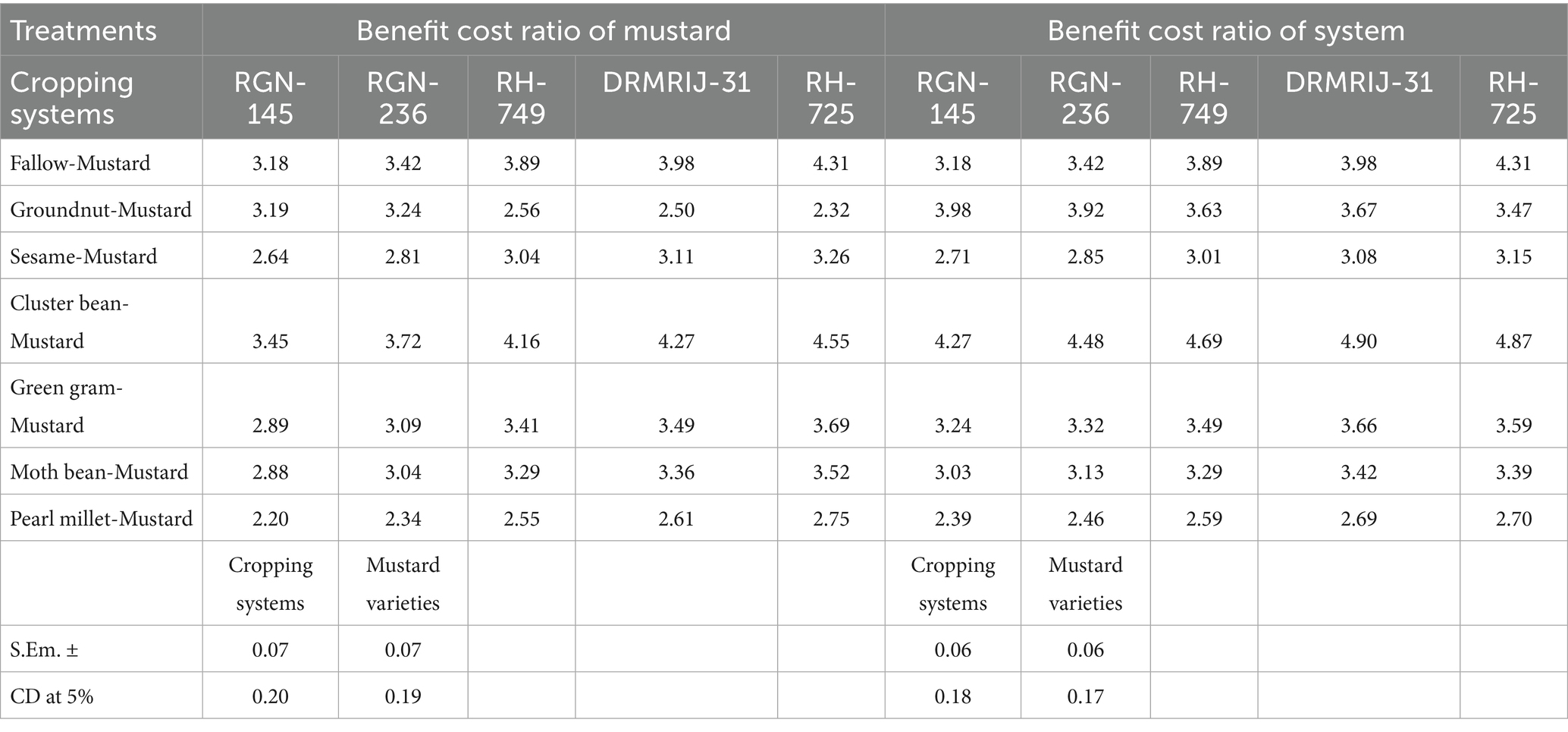
Table 10. Benefit cost ratio of mustard and systems of mustard varieties under different cropping systems (pooled).
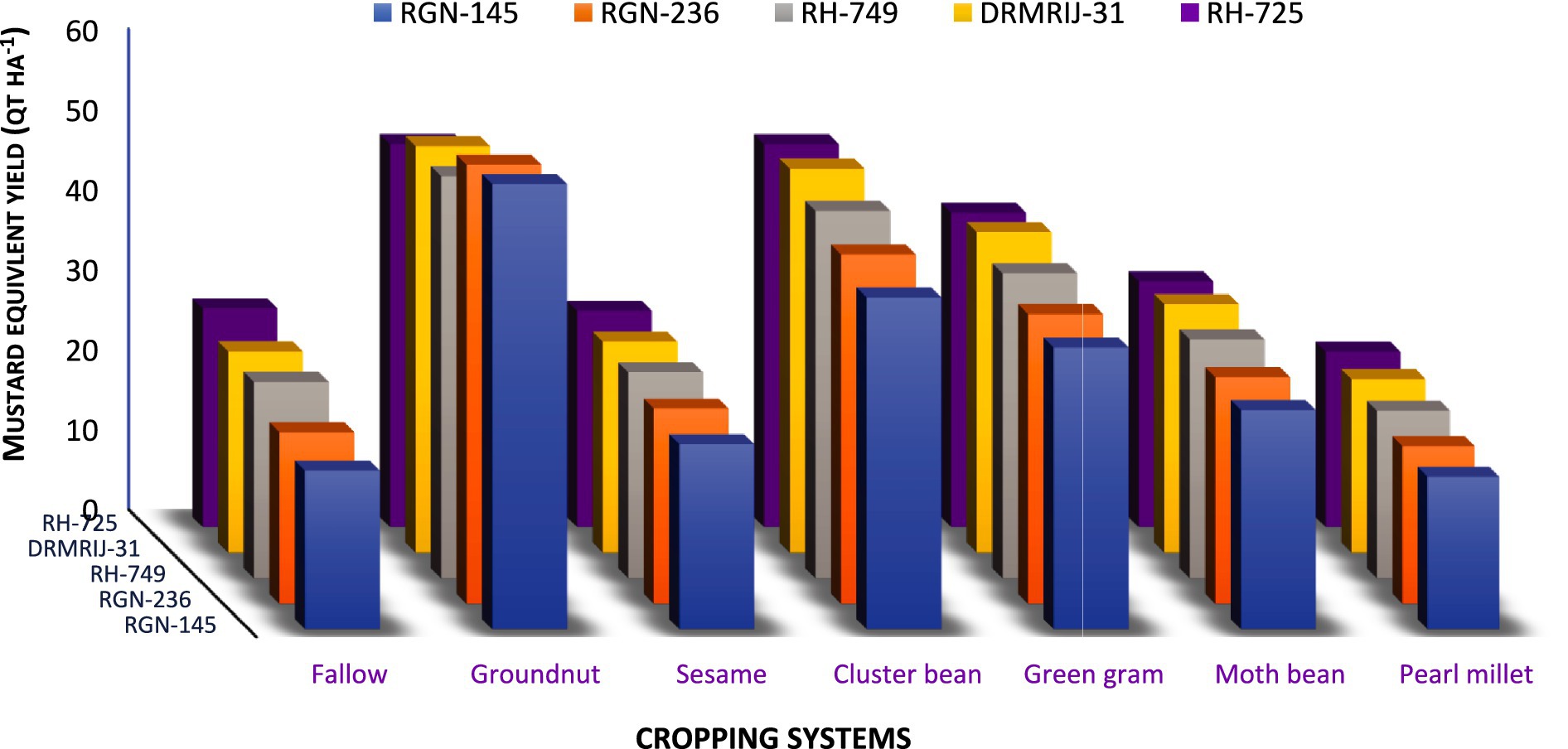
Figure 4. Performance of mustard equivalent seed yield of systems (MESY) under different cropping systems.
In terms of overall cropping system profitability, the Groundnut-Mustard system generated substantial net returns, particularly ₹238,147 for RGN-145. This indicates the synergistic benefits of intercropping with legumes, which not only enhance soil fertility but also contribute to higher economic returns through effective resource utilization (Rani et al., 2023). In comparison, the Cluster bean-Mustard system also showed promising returns, with RGN-145 achieving ₹179,709, highlighting the importance of selecting compatible crops that can thrive together (Mishra et al., 2023).
The Fallow-Mustard cropping system consistently yielded the highest BCR across all mustard varieties, with RH-725 achieving a BCR of 4.31. This suggests that under optimal conditions with minimal competition, mustard varieties can generate substantial returns relative to their costs (Gupta et al., 2022; Figures 4–6). Conversely, the Pearl millet-Mustard system had the lowest BCR, particularly for RGN-145, with a BCR of 2.20. This indicates that the competition from pearl millet reduces the economic efficiency of mustard cultivation in this context (Vaikuntapu and Kumar, 2023). The Cluster bean-Mustard system demonstrated the highest BCR among cropping systems, with values reaching up to 4.90 for DRMRIJ-31. This suggests that the integration of cluster beans with mustard is economically advantageous, likely due to improved resource utilization and complementary growth patterns (Mishra et al., 2023). In contrast, the Groundnut-Mustard system yielded lower BCR values, especially for RH-749 at 2.56, indicating that while intercropping can be beneficial, it may also lead to diminished returns under certain conditions (Rani et al., 2023).
Conclusion
The evaluation of mustard yield attributes, productivity metrics, and harvest index across diverse cropping systems and varieties highlights key strategies for enhancing agroecosystem performance under arid and semi-arid conditions. The consistent superiority of the cluster bean-mustard system, particularly with varieties like RH-725 and DRMRIJ-31, underscores the role of legume-based crop diversification in improving soil nitrogen availability, root-zone resource dynamics, and overall crop vigor. This reflects the ecological benefits of biological nitrogen fixation and complementary nutrient uptake patterns that enhance mustard growth under moisture-limited conditions. The groundnut-mustard system, with MEGY averaging 50–55 q ha−1, demonstrated the highest system productivity, economic return, and land-use efficiency. This suggests that pairing mustard with nutrient-enriching legumes in rotational or sequential systems can serve as a robust climate-smart strategy, particularly in marginal agroecosystems prone to abiotic stress. Overall, the findings reinforce the scientific premise that integrated cropping systems combining leguminous kharif crops with resilient mustard genotypes not only enhance yield stability and profitability but also contribute to climate resilience, soil health regeneration, and long-term sustainability of dryland agriculture. Such approaches are central to advancing sustainable intensification and meeting future food and oilseed demands under changing climatic conditions.
Data availability statement
The original contributions presented in the study are included in the article/supplementary material, further inquiries can be directed to the corresponding authors.
Author contributions
ML: Conceptualization, Data curation, Formal analysis, Investigation, Methodology, Project administration, Resources, Writing – original draft. BS: Conceptualization, Data curation, Formal analysis, Investigation, Methodology, Project administration, Resources, Writing – original draft. SG: Conceptualization, Data curation, Formal analysis, Investigation, Methodology, Project administration, Resources, Writing – original draft. NK: Conceptualization, Data curation, Formal analysis, Investigation, Methodology, Project administration, Resources, Writing – original draft. HJ: Conceptualization, Data curation, Formal analysis, Investigation, Methodology, Project administration, Resources, Writing – original draft. RP: Conceptualization, Data curation, Formal analysis, Investigation, Methodology, Project administration, Resources, Writing – original draft. KK: Supervision, Visualization, Writing – review & editing. PR: Supervision, Visualization, Writing – review & editing. AC: Supervision, Visualization, Writing – review & editing. MM: Supervision, Visualization, Writing – review & editing. AS: Supervision, Visualization, Writing – review & editing.
Funding
The author(s) declare that financial support was received for the research and/or publication of this article. This research was funded by Ongoing Research Funding program, (ORF-2025-958), King Saud University, Riyadh, Saudi Arabia.
Acknowledgments
The authors extend their appreciation to Ongoing Research Funding program, (ORF-2025-958), King Saud University, Riyadh, Saudi Arabia.
Conflict of interest
The authors declare that the research was conducted in the absence of any commercial or financial relationships that could be construed as a potential conflict of interest.
Correction note
A correction has been made to this article. Details can be found at: 10.3389/fsufs.2025.1688226.
Generative AI statement
The author(s) declare that no Gen AI was used in the creation of this manuscript.
Publisher’s note
All claims expressed in this article are solely those of the authors and do not necessarily represent those of their affiliated organizations, or those of the publisher, the editors and the reviewers. Any product that may be evaluated in this article, or claim that may be made by its manufacturer, is not guaranteed or endorsed by the publisher.
References
Bansal, K., and Kumar, R. (2022). The influence of yield components on seed yield in mustard. J. Agric. Sci. 14, 111–120.
Bodner, G., Nakhforoosh, A., and Kaul, H. P. (2015). Management of crop water under drought: a review. Agron. Sustain. Dev. 35, 401–442. doi: 10.1007/s13593-015-0283-4
Choudhary, R., Yadav, A., and Kumar, S. (2022). Intercropping benefits on yield and resource efficiency in mustard cultivation. J. Sustain. Agric. 45, 267–276.
Dowling, A., Roberts, P., Doolette, A., Zhou, Y., and Denton, M. D. (2023). Oilseed-legume intercropping is productive and profitable in low input scenarios. Agricul. Sys. 204:103551.
Emran, S. A., Krupnik, T. J., Aravindakshan, S., Kumar, V., and Pittelkow, C. M. (2022). Impact of cropping system diversification on productivity and resource use efficiencies of smallholder farmers in south-Central Bangladesh: a multi-criteria analysis. Agron. Sustain. Dev. 42:78. doi: 10.1007/s13593-022-00795-3
Friedt, W., Tu, J., and Fu, T. (2018). Academic and economic importance of Brassica napus rapeseed. Brassica napus. Genome., 1–20. doi: 10.1007/978-3-319-43694-4_1
Gawdiya, S., and Kumar, D. (2025). Biological nitrification inhibition enabled climate smart nitrogen efficient genotypes for today and tomorrow. Indian J. Fertil. 21, 112–119.
Gawdiya, S., Kumar, D., Ahmed, B., Sharma, R. K., Das, P., Choudhary, M., et al. (2024). Field scale wheat yield prediction using ensemble machine learning techniques. Smart Agric. Technol. 9:100543. doi: 10.1016/j.atech.2024.100543
Gawdiya, S., Kumar, D., and Sharma, R. K. (2025a). Field based evaluation of wheat cultivars under graded nitrogen levels in north-West India. Front. Agron. 7:1558925. doi: 10.3389/fagro.2025.1558925
Gawdiya, S., Kumar, D., Sharma, R. K., and Singh, S. (2025b). “Policy innovation and governance for sustainable food systems” in Ecologically, Mediated Development Promoting biodiversity conservation and food security (Singapore: Springer Nature Singapore), 219–238.
Gawdiya, S., Kumar, D., Shivay, Y. S., Bhatia, A., Mehrotra, S., Chandra, M. S., et al. (2023a). Field-based evaluation of rice genotypes for enhanced growth, yield attributes, yield and grain yield efficiency index in irrigated lowlands of the indo-Gangetic plains. Sustain. For. 15:8793. doi: 10.3390/su15118793
Gawdiya, S., Kumar, D., Shivay, Y. S., Kour, B., Kumar, R., Meena, S., et al. (2023b). Field screening of wheat cultivars for enhanced growth, yield, yield attributes, and nitrogen use efficiencies. Agronomy 13:2011. doi: 10.3390/agronomy13082011
Gawdiya, S., Kumar, D., Shivay, Y. S., Radheshyam,, Nayak, S., Ahmed, B., et al. (2023c). Nitrogen-driven genotypic diversity of wheat (Triticum aestivum L.) genotypes. Agronomy 13:2447.
Gawdiya, S., Sharma, R. K., Singh, H., and Kumar, D. (2025c). Crop diversification as a cornerstone for sustainable agroecosystems: tackling biodiversity loss and global food system challenges. Discover Appl. Sci. 7, 1–16. doi: 10.1007/s42452-025-06855-z
Génard, T., Etienne, P., Diquélou, S., Yvin, J. C., Revellin, C., and Laîné, P. (2017). Rapeseed-legume intercrops: plant growth and nitrogen balance in early stages of growth and development. Heliyon. 3:e00261. doi: 10.1016/j.heliyon.2017.e00261
Ghorbani, R., Wilcockson, S., Koocheki, A., and Leifert, C. (2008). Soil management for sustainable crop disease control: a review. Environ. Chem. Lett. 6, 149–162. doi: 10.1007/s10311-008-0147-0
Gill, K. S., Kaur, G., Kaur, G., Kaur, J., Kaur Sra, S., and Kaur, K. (2021). Development and validation of kompetitive allele-specific PCR assays for erucic acid content in Indian mustard [Brassica juncea (L.) czern and coss.] Front. Plant Sci. 12:738805.
Gupta, S., Didwania, N., and Singh, D. (2020). Biological control of mustard blight caused by Alternaria brassicae using plant growth promoting bacteria. Curr. Plant Biol. 23:100166.
Gupta, S., Didwania, N., Singh, D., and Chowluru, S. N. (2022). Microbial consortium: an eco-friendly approach against Alternaria brassicae in Indian mustard. Indian Phytopatho. 75, 979–987.
Hasanuzzaman, M. (2008). Siliqua and seed development in rapeseed (Brassica campestris L.) as affected by different irrigation levels and row spacing. Agric. Conspec. Sci. 73, 221–226.
Huhta, A. P., Hellström, K., Rautio, P., and Tuomi, J. (2000). A test of the compensatory continuum: fertilization increases and below-ground competition decreases the grazing tolerance of tall wormseed mustard (Erysimum strictum). Evol. Ecol. 14, 353–372. doi: 10.1023/A:1010808925284
Jain, L. K., Maliwal, P. L., Singh, I., Mundra, S. L., Jain, H. K., Meena, R. H., et al. (2021). Residual effect of organic weed and organic nutrient management practices on weeds parameters, growth attributes, yield and economics of Indian mustard (Brassica juncea L.). Res. Crops, 22, 821–827.
Jain, A., Joshi, G., Chadha, D., Mukhopadhyay, P., Gartaula, H. N., and Puskur, R. (2024). Biofortified mustard, socio-technical innovation bundling approach: empowering women and nurturing resilience
Jain, R., Yadav, A., Sharma, R., and Dhaka, N. (2023). Emerging roles of long non-coding RNAs in regulating agriculturally important seed traits. Plant Physiol. Biochem. 203:108019.
Jain, L. K. (2023). Yield and quality of mustard as affected by organic weed and nutrient management practices.
Joshi, S., and Singh, R. (2022). Exploring yield potential of mustard varieties in varying cropping systems. Indian J. Agric. Sci. 92, 445–450.
Kakraliya, S. K., Singh, U., Bohra, A., Choudhary, K. K., Kumar, S., Meena, R. S., et al. (2018). Nitrogen and Legumes: A Meta-analysis. Legumes for soil health and sustainable management. eds. R. Meena, A. Das, and R. Lal (Hoboken: Singapore: Springer 277–314. doi: 10.1007/978-981-13-0253-4_9
Kaur, G., Kaur, M., and Kumar, R. (2020). Line× tester analysis for quantitative traits in Indian mustard (Brassica juncea L.).
Kermah, M., Franke, A. C., Adjei-Nsiah, S., Ahiabor, B. D. K., Abaidoo, R. C., and Giller, K. E. (2018). N2-fixation and N contribution by grain legumes under different soil fertility status and cropping systems in the Guinea savanna of northern Ghana. Agric. Ecosyst. Environ. 261, 201–210. doi: 10.1016/j.agee.2017.08.028
Krupinsky, J. M., Tanaka, D. L., Merrill, S. D., Liebig, M. A., and Hanson, J. D. (2006). Crop sequence effects of 10 crops in the northern Great Plains. Agric. Syst. 88, 227–254. doi: 10.1016/j.agsy.2005.03.011
Kumar, B. (2021). Plant bio-regulators for enhancing grain yield and quality of legumes: A review. Agricul. Rev. 42, 175–182.
Kumar, R., Saini, D. K., Kumar, M., Priyanka, V., Akhatar, J., and Kaushik, D. (2022). Revealing the genetic architecture of yield-related and quality traits in Indian mustard [Brassica juncea (L.) Czern. and Coss.] using Meta-QTL analysis. Agron. 12:2442.
Kumar, A., and Meena, R. (2021). Impact of intercropping on growth parameters of mustard. J. Agric. Sci. 13, 45–52.
Kumar, A., and Sharma, R. (2021). Evaluation of mustard cultivars for yield and yield attributes under different environmental conditions. Agron. J. 113, 2563–2571.
Kumar, S., Meena, R. S., Singh, R. K., Munir, T. M., Datta, R., and Danish, S. (2021a). Soil microbial and nutrient dynamics under different sowings environment of Indian mustard (Brassica juncea L.) in rice based cropping system. Sci. Rep. 11:5289.
Kumar, S., Meena, R. S., Singh, R. K., Munir, T. M., Datta, R., Danish, S., et al. (2021). Soil microbial and nutrient dynamics under different sowings environment of Indian mustard (Brassica juncea L.) in rice based cropping system. Scientific Reports, 11:5289.
Kumar, A., Singh, R., and Mishra, V. (2022). Effects of intercropping on the yield and profitability of mustard in diverse agro-ecosystems. Field Crop Res. 267, 108–116.
Kumawat, A., Bamboriya, S. D., Meena, R. S., Yadav, D., Kumar, A., Kumar, S., et al. (2022). Legume-based inter-cropping to achieve the crop, soil, and environmental health security. In Advances in legumes for sustainable intensification (Academic Press), 307–328. doi: 10.1016/B978-0-323-85797-0.00005-7
Kundu, D., and Mahapatra, B. (2014). System productivity, profitability and resource use efficiency of jute (Corchorus olitorius) based cropping systems in the eastern indo-Gangetic plain. Indian J. Agric. Sci. 84, 209–213. doi: 10.56093/ijas.v84i2.38033
Liebman, (2000). Integration of soil, crop and weed management in low-external-input farming systems. Weed Res. 40, 27–47. doi: 10.1046/j.1365-3180.2000.00164.x
Lietzow, J. (2021). Biologically active compounds in mustard seeds: a toxicological perspective. Food Secur. 10:2089. doi: 10.3390/foods10092089
Lithourgidis, A. S., Dordas, C. A., Damalas, C. A., and Vlachostergios, D. 0. (2011). Annual intercrops: an alternative pathway for sustainable agriculture. Aust. J. Crop. Sci. 5, 396–410.
Liu, K., Johnson, E. N., Blackshaw, R. E., Hossain, Z., and Gan, Y. (2019). Improving the productivity and stability of oilseed cropping systems through crop diversification. Field Crop Res. 237, 65–73. doi: 10.1016/j.fcr.2019.03.020
Meena, R. S., Das, A., Yadav, G. S., and Lal, R., (2018). Legumes for soil health and sustainable management.
Mendiburu, F.D., and Yaseen, M. (2023). Agricolae: Statistical procedures for agricultural research. R package version 2023.03.1-446. Available online at: https://posit.co/download/rstudio-desktop/ (Accessed January 1, 2023).
Meyer, B. J., Mann, N. J., Lewis, J. L., Milligan, G. C., Sinclair, A. J., and Howe, P. R. (2003). Dietary intakes and food sources of omega-6 and omega-3 polyunsaturated fatty acids. Lipids 38, 391–398. doi: 10.1007/s11745-003-1074-0
Mirdoraghi, M., Farahani, S. M., and Rezazadeh, A. (2024). Oilseeds in intercropping systems: strategies to increase oil quality and fatty acid profile, a review. J. Agric. Food Res. 17:101229. doi: 10.1016/j.jafr.2024.101229
Mishra, S., Singh, R., Upadhyay, A., Mishra, S., and Shukla, S. (2023). Emerging trends in processing for cereal and legume-based beverages: A review. Future Foods, 8:100257.
Moreira, B., Gonçalves, A., Pinto, L., Prieto Lage, M. A., Carocho, M., Caleja, C., et al. (2024). Intercropping systems: an opportunity for environment conservation within nut production. Agriculture 14:1149. doi: 10.3390/agriculture14071149
Nord, E. A., and Lynch, J. P. (2009). Plant phenology: a critical controller of soil resource acquisition. J. Exp. Bot. 60, 1927–1937. doi: 10.1093/jxb/erp018
Palaniappan, S. P. (2006). Cropping systems in the tropics (principles and management) : New Age International.
Patel, P. B., Patel, P. J., Patel, J. R., and Patel, P. C. (2021). Elucidation of genetic variability and inter-relationship studies for seed yield and quality traits in Indian mustard [Brassica juncea (L.) Czern and Coss]. Electronic J. Plant Breed. 12, 589–596.
Patel, M. K., Chaudhary, R., Taak, Y., Pardeshi, P., Nanjundan, J., Vinod, K. K., et al. (2022). Seed coat colour of Indian mustard [Brassica juncea (L.) Czern. and Coss.] is associated with Bju. TT8 homologs identifiable by targeted functional markers. Front. Plant Sc. 13:1012368.
Rai, P. K., Yadav, P., Kumar, A., Sharma, A., Kumar, V., and Rai, P. (2022). Brassica juncea: a crop for food and health. The Brassica juncea genome (pp. 1–13). Cham: Springer International Publishing.
Rani, V., Bhatia, A., and Kaushik, R. (2021). Inoculation of plant growth promoting-methane utilizing bacteria in different N-fertilizer regime influences methane emission and crop growth of flooded paddy. Sci. Total Environ. 775:145826.
Rani, P., Rose, P. K., Kidwai, M. K., and Meenakshi,. (2023). Brassica Juncea L.: a potential crop for phytoremediation of various heavy metals. In Heavy metal toxicity: environmental concerns, remediation and opportunities. Singapore: Springer Nature Singapore. 285–311.
Ravi, S., Rangasami, S. R., Vadivel, N., Kumar, T. P., Harishankar, K., Shankar, S. V., et al. (2024). Productivity and econometric analysis of leguminous monkey-nut (Arachis hypogaea L.) as influenced by growth retardant. Legume Res. 47, 52–58.
Reddy, A. A., Sanyal, S., and Pratap, A. (2024). Policies and incentives to promote pulses: Indian perspective. In Potential pulses: Genetic and genomic resources (GB: CABI), 310–340. doi: 10.1079/9781800624658.0016
Reddy, K., Verma, S., and Kaur, A. (2023). Enhancing profitability in mustard through strategic crop rotations. Indian J. Agron. 68, 144–150.
Sachan, D. S., Naimuddin, S. K., Patra, D., Subha, L., Senthilkumar, T., Chittibomma, K., et al. (2024). Advancements in enhancing oil quality in rapeseed and mustard: a comprehensive review. J. Exp. Agric. Int. 46, 181–193. doi: 10.9734/jeai/2024/v46i52369
Saini, R. K., and Keum, Y. S. (2018). Omega-3 and omega-6 polyunsaturated fatty acids: dietary sources, metabolism, and significance—a review. Life Sci. 203, 255–267. doi: 10.1016/j.lfs.2018.04.049
Sarkar, D., Baishya, L. K., Meitei, C. B., Naorem, G. C., Thokchom, R. C., Singh, J., et al. (2018). Can sustainability of maize-mustard cropping system be achieved through balanced nutrient management. Field Crop Res. 225, 9–21. doi: 10.1016/j.fcr.2018.05.018
Sharma, A., Garg, M., Sharma, H. K., and Rai, P. K. (2024). “Mustard and its products” in Handbook of spices in India: 75 years of research and development. eds. A. Sharma, M. Garg, H. K. Sharma, and P. K. Rai (Singapore: Springer Nature Singapore), 2385–2451.
Sharma, D., Nanjundan, J., Singh, L., Parmar, N., Singh, K. H., Verma, K. S., et al. (2022). Genetic diversity and population structure analysis in Indian Mustard germplasm using phenotypic traits and SSR markers. Plant Molecular Biology Rep. 40, 579–594.
Singh, B., Aulakh, C. S., and Walia, S. S. (2019). Productivity and water use of organic wheat–chickpea intercropping system under limited moisture conditions in Northwest India. Renew. Agricul. Food Sys. 34, 134–143.
Singh, K., Ram, H., Kumar, R., Meena, R. K., and Kumar, R. (2021). Fodder quality and yields of mung bean as influenced by different weed management practices. Indian J Animal Nutri. 38, 233–239.
Singh, H. V., Sharma, A. K., Kumar, A., Kumar, V., Sharma, P., Nath, M. J., et al. Yield enhancement of rapeseed-mustard through innovative transplanting technique in Assam. (2023) 148–153.
Singh, L., Nanjundan, J., Sharma, D., Singh, K. H., Parmar, N., Jain, R., et al. (2022). Agro-morphological traits and SSR markers reveal genetic variations in germplasm accessions of Indian mustard–an industrially important oilseed crop. Heliyon, 8.
Singh, J., Singh, V., Dutt, V., Walia, N., Kumawat, G., Jakhar, M. L., et al. (2022). Insights into salt tolerance of mustard (Brassica juncea L. Czern & Coss): a metabolomics perspective. Environ. Experim. Botany, 194: 104760.
Sudhalakshmi, C., Rani, S., Sathyamoorthi, N. K., Meena, B., Ramanathan, S. P., et al. (2022). Microclimate modification through groundnut-pigeon pea intercropping system and its effect on physiological responses, disease incidence and productivity. Legume Res Intern J. 45, 1122–1129.
Thakur, A. K., Mandal, K. G., Mohanty, R. K., and Uphoff, N. (2022). How agroecological rice intensification can assist in reaching the Sustainable Development Goals. Intern. J. of Agricul. Sustain. 20, 216–230.
Thakur, A., and Sharma, P. (2023). Correlation between yield attributes and seed quality in mustard varieties. J. Sustain. Agric. 15, 20–30.
Thakur, M., Chopra, P., Kumar, S., Sharma, T., and Singh, A. (2023). Efficacy of different herbicides for controlling grass predominant weed flora and achieving higher production in dual purpose linseed under mid hills of Himachal Pradesh. Environ. Ecol. 41, 2845–2852.
Vaikuntapu, P. R., and Kumar, V. D. (2023). Applications and challenges of harnessing genome editing in oilseed crops. J. Plant Biochem. Biotechnol. 32, 751–772.
Verma, P., Tandon, R., Yadav, G., and Gaur, V. (2020). Structural aspects of DNA repair and recombination in crop improvement. Front Genetics, 11:574549.
Verma, S., Dubey, N., Singh, K. H., Parmar, N., Singh, L., Sharma, D., et al. (2023). Utilization of crop wild relatives for biotic and abiotic stress management in Indian mustard [Brassica juncea (L.) Czern. & Coss.]. Front Plant Sci. 14, 1277922.
Wanic, M., Zuk-Golaszewska, K., and Orzech, K. (2019). Catch crops and the soil environment–a review of the literature. J. Elem. 24. doi: 10.5601/jelem.2018.23.3.1638
Keywords: cropping system, mustard, net return, profitability, system productivity
Citation: Lal Reager M, Singh Kherawat B, Gawdiya S, Kishor N, Jatav HS, Pant R, Kumari K, Ram Raiger P, Choudhary A, Mattar MA and Salem A (2025) Assessing cropping systems and mustard varieties for enhanced system yield and profitability: strategies for climate resilience in arid Western Rajasthan. Front. Sustain. Food Syst. 9:1608410. doi: 10.3389/fsufs.2025.1608410
Edited by:
Vijay Singh Meena, Indian Agricultural Research Institute (ICAR), IndiaReviewed by:
Abhishek Singh, Yerevan State University, ArmeniaLalit Kumar Rolaniya, Indian Institute of Pulses Research (ICAR), India
Copyright © 2025 Lal Reager, Singh Kherawat, Gawdiya, Kishor, Jatav, Pant, Kumari, Ram Raiger, Choudhary, Mattar and Salem. This is an open-access article distributed under the terms of the Creative Commons Attribution License (CC BY). The use, distribution or reproduction in other forums is permitted, provided the original author(s) and the copyright owner(s) are credited and that the original publication in this journal is cited, in accordance with accepted academic practice. No use, distribution or reproduction is permitted which does not comply with these terms.
*Correspondence: Hanuman Singh Jatav, aGFudW1hbmlhc2JodUBnbWFpbC5jb20=; Mohamed A. Mattar, bW1hdHRhckBrc3UuZWR1LnNh; Ali Salem, c2FsZW0uYWxpQG1pay5wdGUuaHU=
 Madan Lal Reager1
Madan Lal Reager1 Sandeep Gawdiya
Sandeep Gawdiya Hanuman Singh Jatav
Hanuman Singh Jatav Mohamed A. Mattar
Mohamed A. Mattar Ali Salem
Ali Salem

